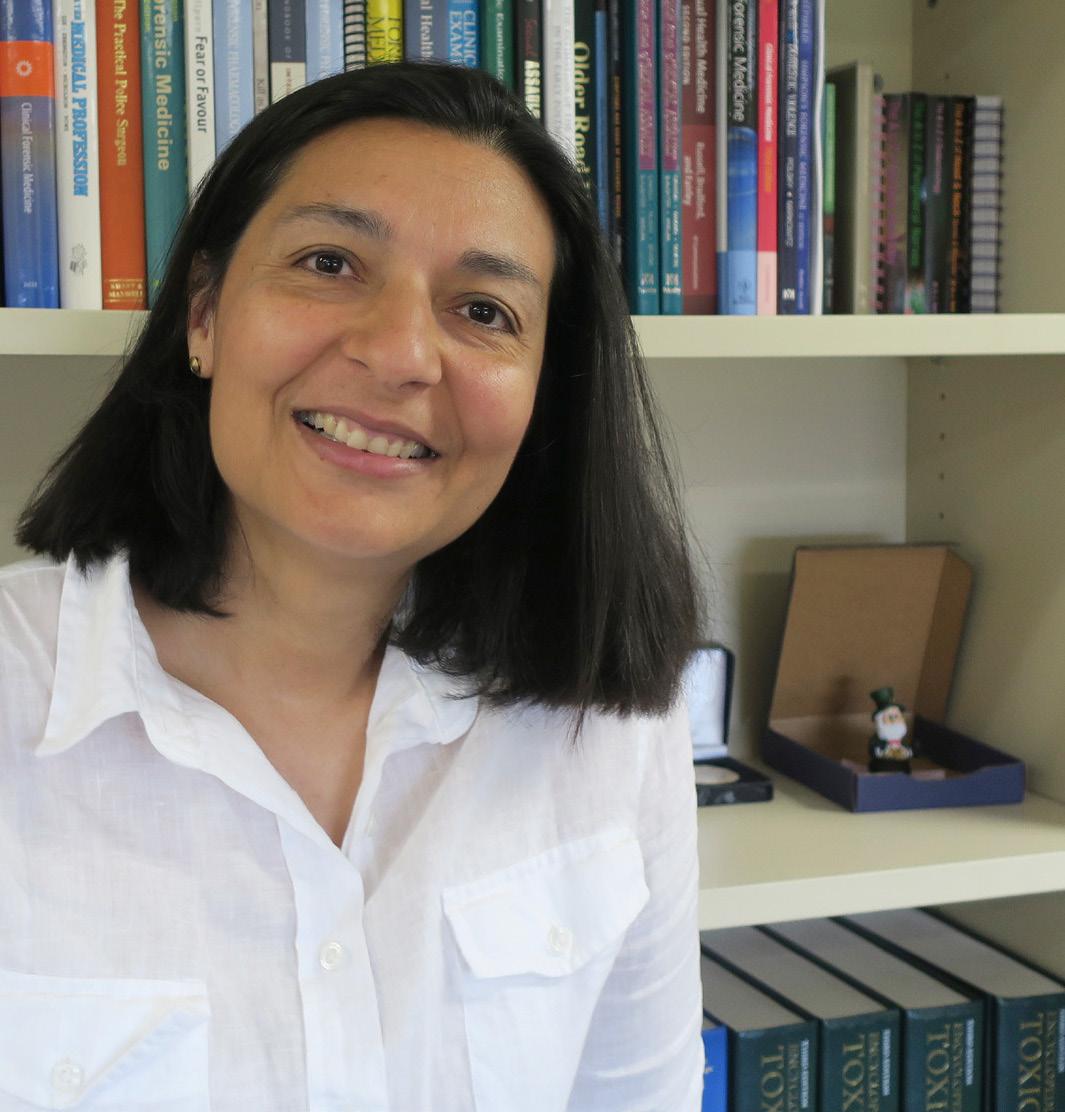
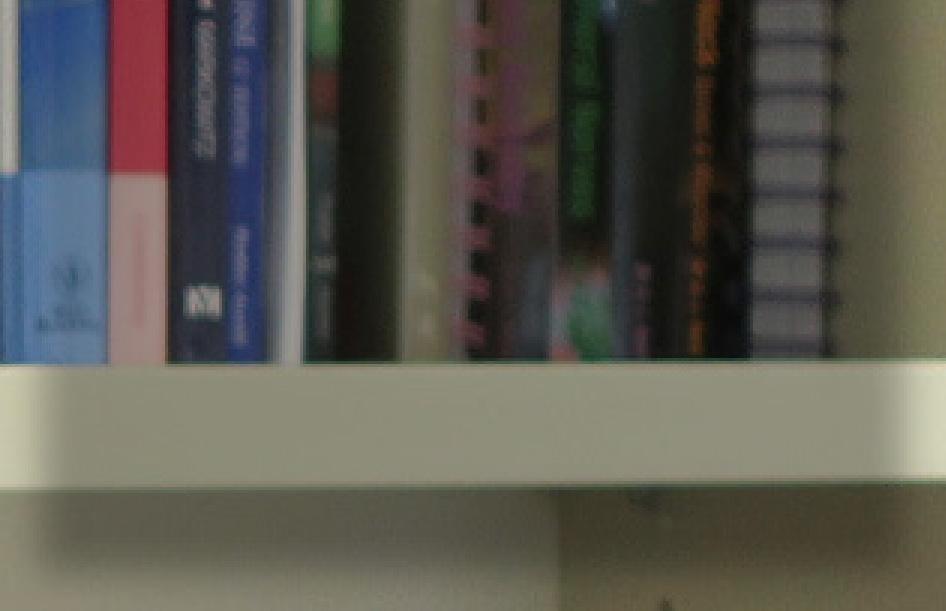




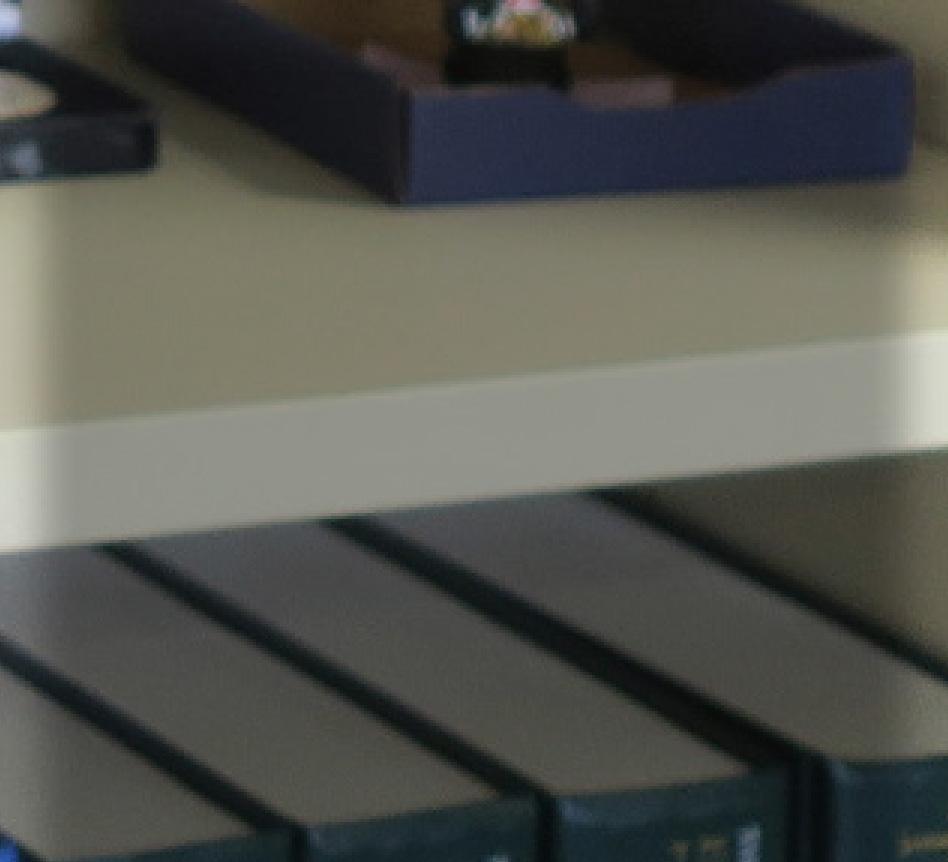



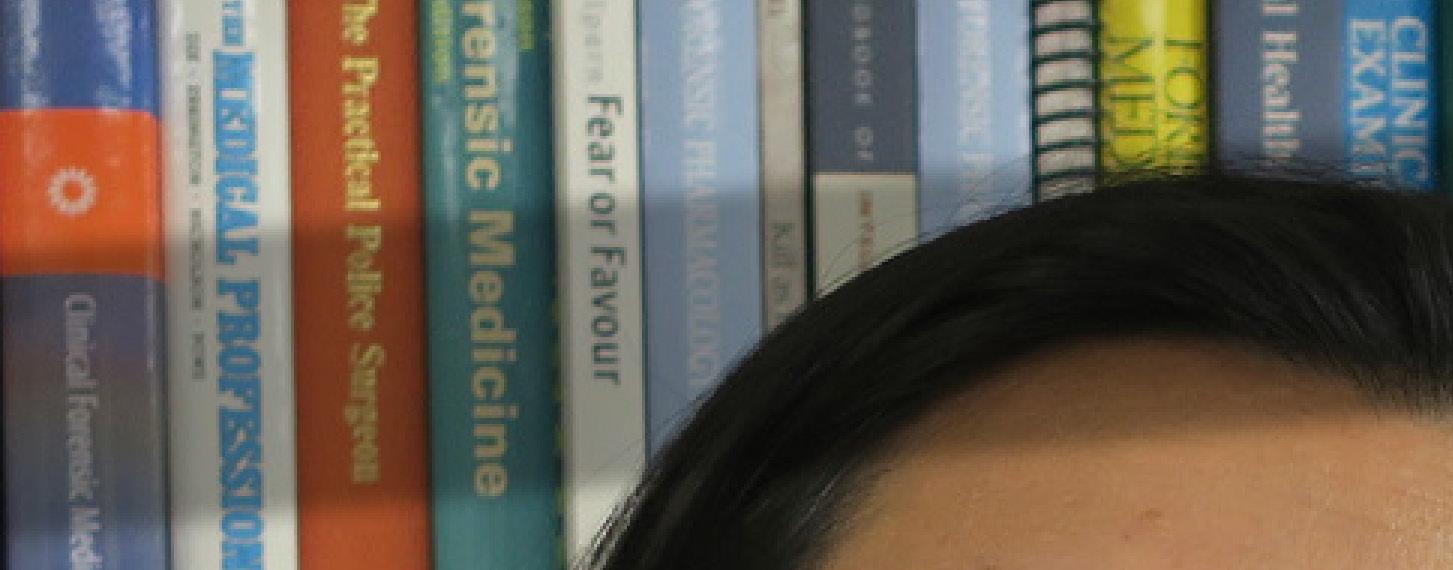



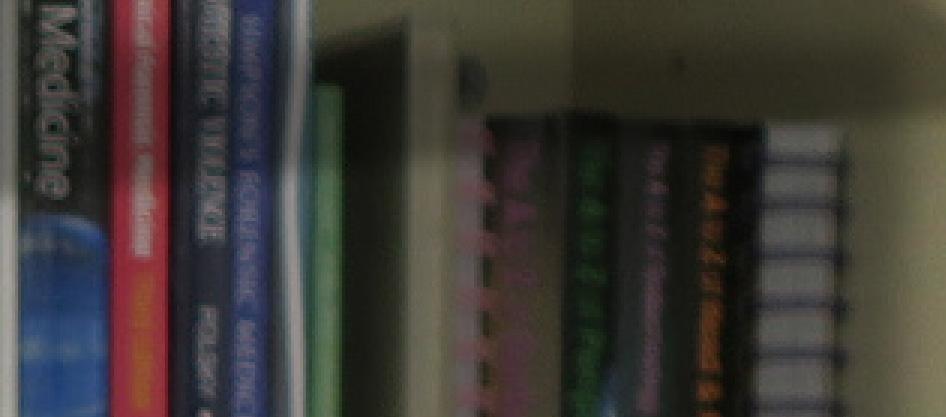

FEBRUARY 2018 1
AC
Dr Mukesh Chandra Haikerwal
AM
Dr Vanita Rajul Parekh
AM
Prof Sharad Kumar
AM FREE FEBRUARY 2018 • info@indianlink.com.au • www.indianlink.com.au MELBOURNE SYDNEY • MELBOURNE • ADELAIDE • BRISBANE • PERTH • CANBERRA Level 24/44 Market St, Sydney 2000 • GPO Box 108, Sydney 2001 • Ph: 18000 15 8 47 • email: info@indianlink.com.au AUSTRALIA DAY HONOURS
Anant Kaur Sandhu
Indian Festival Melbourne
Proud to be a part of the Melbourne

Food and Wine Festival

24-25 Mar
Queen Vic Market

Shake a leg to Bollywood music or try some Bhangra
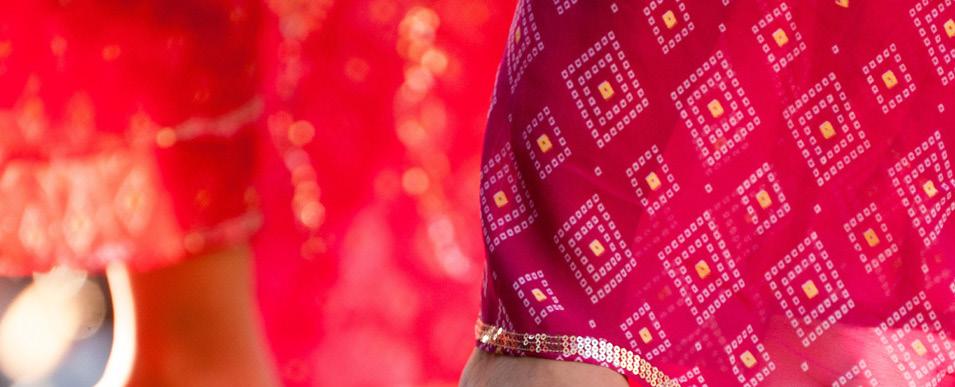
Enjoy some of the best Indian food trucks & stalls
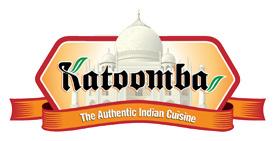
FUN activities for the whole family - All entertainment is FREE
Tickets for the Katoomba VIP Pavillion Now available. Visit the website to book your place.
Follow us for prizes and giveaways including a trip for TWO to India




@indianfestivalmel
www.indianfestivalmel.com.au

Curated by

Supported by


For sponsor information email himanshi@foodietrails.com.au



2 FEBRUARY 2018 www.indianlink.com.au
History is not set in stone
BY PAWAN LUTHRA
At this time of the year every year, there is much debate in Australia about two events which divide the community.
The first relates to Australia Day. The sound cloud around the appropriateness of the date 26 January is currently dominating social media. Those calling for a rethink of the celebratory jingoism on this day actually refer to this date as Invasion Day, marking the start of the forcible decline of their culture.
Others believe that Australia Day on 26 January marks the foundation of the nation in its modern form, and there is no reason for change. That celebrations on this day hurt the feelings of the Indigenous population, is conveniently ignored by this group.

That history can be reinterpreted, may resonate more with the Indian-


Australian community, thanks to the well-publicised argument put forward by contemporary Indian writer and politician Shashi Tharoor. His demand for Britain to make reparations to India for the brutality it inflicted on India’s economy and society after it invaded the country in the 19th century has been heard, read and lauded many times over the past year. The ever-articulate Tharoor brought to world attention that only one side of the Imperial domination has been depicted in history books, while the exploitation of the people and the gradual denuding of the country’s resources has largely gone by unacknowledged, indeed even unnoticed. History needs to relook at this dark chapter rather than glorify the British empire, Tharoor argued to much acclaim.

Even the ongoing controversy in India about Bollywood’s newest historical Padmaavat is an illustration of how in that case, history can be distorted to fit modern-day interpretations. History can indeed be reinterpreted over time. We look at history through
the prism of our own experiences and what we are aware of in the contemporary world around us. As well, we are connected in multiple ways these days: this not only allows us more avenues to learn about the world, it also helps us find like-minded people and use the collective wisdom to press for change. Whether that change is for the better or not, yes, only history will tell. The other local event which divides the community at this time of year, is the idea of Australia moving away from the monarchy and becoming a republic. Indian-origin readers are well-aware that 26 January also marks India’s Republic Day: on this day in 1950, India finally broke all the shackles of two centuries of British rule. Adopting its own Constitution, India also chose its own Head of State. That Australia, in the 21st century, continues to swear allegiance to a monarchy thousands of miles away, is somewhat astounding: it is definitely an issue worth a revisit. If history is any guide, both these controversial issues will be resolved. Which way, only history will tell.
FEBRUARY 2018 3
Pawan Luthra EDITOR Rajni Anand Luthra ASSISTANT EDITOR Harshad Pandharipande MELBOURNE COORDINATOR Preeti Jabbal CONTRIBUTORS Sudarshan Arvind, Nanditha Suresh, Carl Buhariwala, Saroni Roy, Jyoti Shankar, Rajni Madan, Sandip Hor, Somitra Ghosh, Ritam Mitra, Mital Parekh, Saket Suman, Dhanya Samuel, Auntyji, Aparna Ananthuni, Minal Khona, ADVERTISING MANAGER Vivek Trivedi 0410 578 146 Indian Link is a fortnightly newspaper published in English. No material, including advertisements designed by Indian Link, may be reproduced in part or in whole without the written consent of the editor. Opinions carried in Indian Link are those of the writers and not necessarily endorsed by Indian Link. All correspondence should be addressed to: INDIAN LINK MEDIA GROUP Level 24/44 Market St, Sydney 2000 GPO Box 108, Sydney 2001 Ph: 02 9279-2004 Fax: 02 9279-2005 Email: info@indianlink.com.au
PUBLISHER
EDITORIAL Upgrade from Economy to Business Class with the ‘Get Upfront Offer’ by paying an upgrade amount of AUD 899 * * TERMS & CONDITIONS APPLY

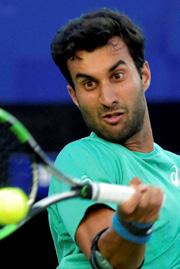


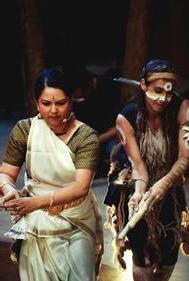
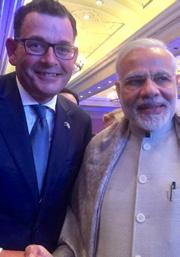
4 FEBRUARY 2018 www.indianlink.com.au Australia Day Honours 8 27 21 12 COVER STORY SPECIAL FEATURES 12 INDIA OZ Premier Daniel Andrews’ India visit 16 WELLNESS Anxiety disorder in youngsters 21 INTERVIEW Deepika Padukone on Padmaavat 27 SPORT Exciting new talent at Australian Open 31 ARTS Multicultural Arts Victoria’s Mapping Melbourne Festival CONTENTS 31
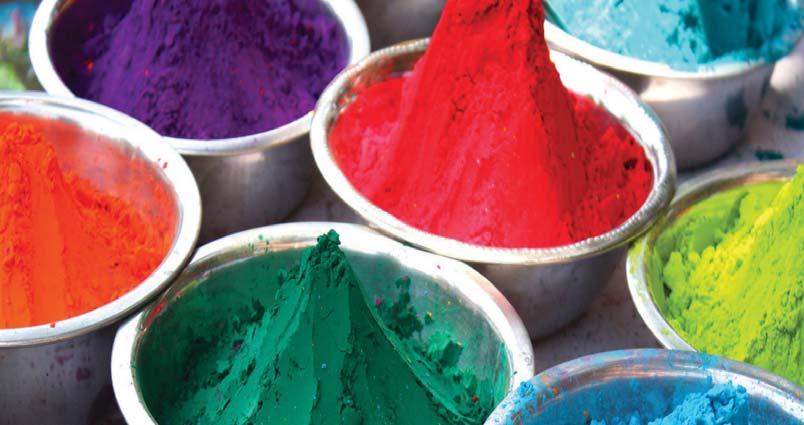



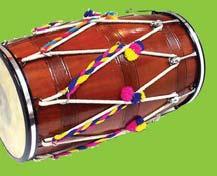












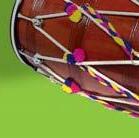






























































FEBRUARY 2018 5 LIVE DJ, DHOLI & CULTURAL PROGRAMS. STRICTLY NONALCOHOLIC & DRUGS FREE EVENT. MANAGEMENT HAS THE RIGHT TO RESTRICT THE ENTRY AMPLE FREE CAR PARKING AVAILABLE Live performance by Local Artists Kids Games and Rides CELEBRATING HOLIKA DAHAN 4.30PM www.sridurgatemple.com Download Temple App –“DurgaMandir” FOR SPONSORSHIP / MARQUEES OR OTHER INFO CONTACT: PRESIDENT: 0423 456 997 SECRETARY: 0412 914 548 TREASURER: 0430 765 761 FOR DIRECT DEPOSIT, TEMPLE BANK DETAILS ARE: BSB - 063212 ACCOUNT NO - 10160544 PLEASE DONATE GENEROUSLY MARKETING@SRIDURGATEMPLE.COM STAGE 2c (Veranda) CONSTRUCTION UNDERWAY FREE ENTRY MULTICULTURAL FAMILY FUN DAY EVENT MULTICULTURAL FAMILY FUN DAY EVENT SUNDAY 4th MARCH 2018. 11.00 AM - 5.00PM SUNDAY 4th MARCH 2018. 11.00 AM - 5.00PM 705 NEALE RD ROCKBANK , VIC 3335 PHONE: (03) 9747 1628 705 NEALE RD ROCKBANK, VIC 3335 PHONE: (03) 9747 1628
YOUR SAY
CLASS OF 2017
Our stories on Year 12 students prompted other school finishers to share their experiences and performance
SONALI YARDI Baulkham Hills High School ATAR 99.85

Achievements Ranked 1st in School (Legal Studies), School Academic Achievement awards for Legal Studies and Economics
Sonali wrote: Having witnessed others go through the HSC, I had expected that the year would be filled with stress, piles of homework and an exam every week. However in reality, to my surprise, my HSC year, although plagued with these things at certain times, was much more fun than stress. I was able to strengthen my friendships and make new ones whilst having new experiences and enjoy the last year of school! The most important thing I learned about myself is to have faith in my abilities. By picking a notoriously “low scaling subject,” I was told that I wouldn’t be able to do as well because I chose this subject. But I ignored such negativity and tried to have faith in my ability and love for Legal studies. Further, moving to a new school helped me to realise that I had the strength to adapt to a new environment and excel. I also learnt that strong self-motivation is the only way one can achieve success as only you can get the best out of yourself
My advice to students would be to just relax and enjoy your last year of school. This is going to be a tough, long year but with hard work and perseverance you will get through it. Also, pick subjects you genuinely enjoy. This will make Year 12 a lot more fun and heaps less stressful. And finally, English (unfortunately) is very important, so put as much time and effort into it as you can. You won’t regret it.
Normanhurst Boys High School
ATAR 99.50
Achievements HSC Premier’s Award for All - Round Excellence, Year 12 High Achievers Award from school, HSC Distinguished Achiever
Kiran wrote: Over the course of the HSC year, I learnt the importance of being able to strive beyond one’s comfort zone and reach success beyond my expectations. If I were given the opportunity, I would have extended myself to actively participate in more community events, allowing me to develop my interpersonal skills through communication and networking, all whilst having fun and helping others. Alongside pushing yourself to participate in a vast array of extracurricular activities, a boringly practical yet equally important piece of advice would be to purchase a comfortable pen for the year. Whilst a cheap pack of Biro pens maybe tempting, a couple higher quality pens will allow you to write clearer, faster and in higher quantity without as many painful hand cramps.
SAY IT AGAIN
TANMAY GUPTA Mazenod College ATAR 99.70


Achievements College DUX, Subject Awards in Specialist Maths and Chemistry, Science Scholarship, Long Tan Leadership and Teamwork Award
Our coverage of the Class of 2017 stories got wide appreciation. Chandra Kishore wrote: Indian Link, your cover picture with our young ones’ HSC achievements is very much appreciated. We need to boost the image of our community and you have just done that. Much appreciated. Keep it up.
Harshad Pandharipande wrote: Loving the jersey names of all the students. So clever and fun. Laughed out loud at some many of them and thinking what my daughter’s jersey name would be!
LEARNING TELUGU IN SYDNEY
NANDITHA SURESH wrote about the man behind Telugu schools in NSW. He expressed his gratitude

Mallik Rachakonda wrote: Thank you for taking time out to writing about Telugu schools in Sydney. This article will provide much needed coverage about our schools and enable many parents to enrol their children in Telugu schools
ACCOLADES FOR IFFM DIRECTOR
Mittu Bhowmick Lange became the first Australian-Indian woman to receive the prestigious Jill Robb Award, reported PREETI JABBAL Sheba Nandkeolyar wrote: Mitu your professionalism, creativity and humility has set a new benchmark for the Australian Indian Diaspora. We are very proud of you.
A strong India is key to stability in the Indian Ocean Sen Penny Wong, at the Australia-India Leadership Dialogue in New Delhi

We haven’t taken care of our beaches as much as Australia has Bollywood actor Parineeti Chopra
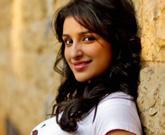
6 FEBRUARY 2018 www.indianlink.com.au
KIRAN KUMAR
50 YEARS AS A GP
Our Facebook post on Adelaide’s sari-clad Indian doctor by RAJNI MADAN saw an outpouring of congratulatory messages. Read the story on page 17 of this issue
Nirmala Sekhar wrote: Congrats Jaya Pathi on this wonderful achievement. Lakshmi Sreedhar wrote: Most humble and the bestest

Ganesh Ananthakrishnan wrote: Congratulations Jaya Aunty! Wonderful recognition of a stellar career and for dedicated service to the health needs of the Northern suburbs communities
Sukanya Ramachandran: Congrats Chitti. Ur eldest sister and all of us r feeling very proud of u. We pray to God for ur long healthy and happy life. Take care
INDIAN LINK POLL RESULTS
Here’s what you, the readers, said about some recent issues
Do you support same-sex marriage in Australia?
52% Yes
39% No
9% Don’t care
After all the controversy, will you still watch Padmaavat?

63% Yes, I can’t wait
18% No, it portrays history wrongly
13% Wasn’t planning to, but now I’m curious
6% I’m not interested in Hindi movies
WHERE IN INDIA
Our quiz about Indian destinations got correct responses this time
Vaishali Patel wrote: It’s in Meghalaya. Mythili Iyer wrote: It is in Meghalaya.

WALLABY ON SYDNEY HARBOUR BRIDGE
The video of the wayward wallaby expectedly got a lot of laughs
GURUDWARA BAN

Certain developments in the Indian and Sikh diaspora are an unfortunate setback to India as it continues to develop its soft influence overseas, wrote
PAWAN LUTHRA
JK2020 wrote: The Indian government must stop interfering with Sikh institutions overseas. Bring the 1984 culprits to justice and stop abusing Punjab’s waters.
BBL IN HINDI
Our Hindi commentary was a hit among listeners NRIofTheYear wrote: #Hindi commentary during @BigBashLeague is so awesome to listen to. Thank you @CricketAus.
We must never stop learning from this man Vic Premier Daniel Andrews, visiting India, about Gandhi


Mark Pointer wrote: Think he was tryin to get the hell out of Sydney!!! Raghwa Sharma wrote: Now u talkin, Straya!
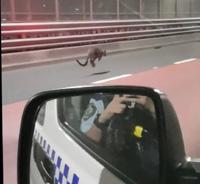
+ JOIN THE CONVERSATION
> LOG on to your own Facebook or Twitter account
> TYPE “Indian Link” into the search box at the top of the screen and click on the link that comes up
> CLICK ‘Like’ to join the Indian Link Facebook community or ‘Follow’ @Indian_Link on Twitter


… be expansive in your discussions. Consider bold ideas. I look forward to hearing the outcomes of this important gathering PM Malcolm Turnbull to the Australia India Youth Dialogue

FEBRUARY 2018 7
AUSTRALIA DAY
THE GOOD DOCTOR Dr Mukesh Chandra Haikerwal, AC
For eminent service to medical governance, administration, and technology, and to medicine, through leadership roles with a range of organisations, to education and the not-for-profit sector, and to the community of western Melbourne
For Dr Mukesh Haikerwal, every day is a sense of celebration of what it means to be Australian. Therefore, to get the highest civilian honour on Australia Day is ‘truly life changing’ and ‘extremely humbling.’
The accomplished GP has been appointed as a Companion in the General Division of the Order of Australia (AC) for eminent service to medical governance, administration, and technology, and to medicine, through leadership roles with a range of organisations, to education and the not-for-profit sector, and to the community of western Melbourne.
“For me, to be in a position in my life and career to receive such an honour has only been made possible due to the unflinching support and unremitting encouragement of my closest circle, the people who have been with me through every step of endeavour, adversity, achievement, and success” said Haikerwal.
The eminent doctor, who runs a practise in Altona North, has received a string of accolades during his career for his contributions to the medical profession.
His leadership roles include being the youngest Federal President of the Australian Medical Association (20052007) and Chairman of Council for the World Medical Association (2011-2015).
Haikerwal was awarded the Order of Australia in 2011 for distinguished service to medical administration, to the promotion of public health through leadership roles with professional organisations, to the reform of the Australian health system through the optimisation of information technology, and as a general practitioner.

Haikerwal is particularly proud of the work he did with the specially-convened National Health and Hospitals Reform Commission as part of a team, and with the Australian Institute of Health and Welfare.
“Allowing me the opportunity to make a difference has been due to the great organisations and people within them, that on the whole were kind to me and listened and learnt,” said Haikerwal.
“These are organisations that dedicate themselves selflessly to bettering the
lives of others. They are the collaborators and partners right across the nation and across the globe that have joined to help us all ‘do the right thing’ - to be brave and bold, and lead for the people,” he emphasised.
With increased focus on charity, he is currently on the board as director of Beyond Blue, providing guidance and contributing to its efforts to improve the mental health of health professionals.
He is working with Cancer Victoria with its aim to improve advocacy and knowledge of cancer, cancer care and facilities. He is also involved with Brain Injury Australia in response to his own recovery from a brutal attack in 2008.
In September 2008, Haikerwal survived a vicious gang attack and robbery near Dennis Reserve in Williamstown. The attackers inflicted serious injury with a baseball bat that left Haikerwal brain damaged and within inches of losing his life. He had to be put in a medically induced coma to survive and had to relearn how to walk and talk again.
Lucknow-born Haikerwal is the eldest
son of Dr Madhuri and Ishwar, both Indian-British citizens, who migrated to Australia in 1981. Haikerwal started his education in a London Boarding school at the age of 6 and went on to study Medicine in Leicester.
In 1990, he moved to Australia with his wife Dr Karyn Alexander and set up practice in Altona North. He has three sons Suresh, Ajaya and Jeevan.
“First and foremost, I am a GP – a local family doctor who serves his local community. This defines me,” said Haikerwal.
“It is a privilege to have as a basis, my foundation, the hard-working people, the salt of the earth, the everyday folk who have come from every corner of the globe to live and work in our proudly diverse and multicultural region. They give so much to this great country,” he continued.
“Our daily continuing challenge is to provide high-quality, patient-centred, holistic care in a region with pitifully low levels of investment. That daily challenge - those daily encounters with real people, real patients - has provided me with the
burning arrows of desire: to improve the lot of the common man,” said the soft spoken GP
Whether he is confronting racism by condemning abuse of international medical graduates or promoting technology and eHealth initiatives to deliver better patient care or debating voluntary euthanasia, Haikerwal is leading the charge.
According to him, expending energy on multiple commitments is possible by ensuring a healthy body and a healthy mind.
“I am careful with my intake of salt, sugar and saturated fats. I eat sensibly, exercise, visit my GP regularly and look after my mental and physical health,” he said referring to the physicians pledge as part of the WMA Declaration in Geneva.
He wishes to dedicate the Australia Day Honour to all his colleagues.
“I would have achieved little without my chariots of fire - my professional colleagues from within medicine, and from disciplines aligned to health, healthcare, welfare, and service planning and delivery,” said Haikerwal.
“In particular, I salute those who have lost their lives in their pursuits, for whom I will continue to strive, as they would have, to improve the health of the nation and the happiness of those who pursue it,” he said.
Preeti Jabbal
8 FEBRUARY 2018 www.indianlink.com.au
COVER STORY
First and foremost, I am a GP – a local family doctor who serves his local community. This defines me
HONOURS
OF HEALING AND HOPE Dr Vanita Rajul Parekh, AM
For significant service to medicine as a specialist in the fields of sexual health and forensic medicine, as an educator and clinician, and to professional associations
The girl was just 15 years old. She had been raped, and was understandably in deep trauma. She needed not just immediate medical help but also forensic attention to gather evidence of the ordeal she had gone through. Unfortunately, the Australian Capital Territory did not have a forensic medical service at the time, in year 2000.
That’s when the ACT government dialed Dr Vanita Rajul Parekh for help.
Dr Parekh, a practising gynaecologist, had done significant work, visiting brothels and interacting with the women working there to monitor their sexual health and awareness.
The government asked Dr Parekh to head a forensic medical service, and she took up the challenge. Since then, she has been working to help victims - women and men - of sexual violence. Till date, Dr Parekh has lent her expertise in 2,500 such cases.
Since 2006, Dr Parekh, who is 48 years old, has been the unit director of Clinical Forensic Medical Services (CFMS), which includes Forensic and Medical Sexual Assault Care and Clinical Forensics ACT. She provides a comprehensive range of medical care to individuals who have been sexually assaulted or are in police custody, and provides regular evidence to the courts in the ACT.
For her work in the field of sexual health and forensic medicine, she was conferred with the Member of the Order of Australia in the 2018 Australia Day Honours, something she says she is humbled and honoured about.
Dr Parekh’s journey to Australia is quite interesting. Her grandparents migrated to East Africa from Rajkot in Gujarat. Her parents then moved to Edinburgh in Scotland, where she was born and raised. “It was very different growing up there,” she remembers. “I was the only brown kid in school.”
She studied medicine in Glasgow and moved to Australia in 1995 as there was a ‘massive shortage’ of doctors here at the time. “My first day, I walked in to work and the people there, surprised by my Indian features, said, ‘But we’re expecting a doctor from Scotland.’ I told them ‘Yes, that’s me!’” she remembers with a laugh.
Dr Parekh had planned to work in Australia for just a year but says she fell in love with the place and its kind people. “I remember getting nine invitations for
Christmas the first year I moved here,” she says. “Everyone made me feel as if I belonged. That’s when you feel a commitment to give something back to the society.”
And give back she did. Dr Parekh’s foray into sexual health came when she started meeting ‘working women’ in brothels - prostitution was decriminalised in the ACT in 1992. “I realised then everyone, irrespective of background, had a right to sexual wellbeing,” she says.
The turning point came in the year 2000 when, after the 15-year-old girl’s rape case, Dr Parekh was asked by the ACT government to head the medical forensic service to help victims of sexual violence and domestic violence. “The forensic aspects were not as developed then as they are now. But we had a team of committed doctors who wanted to make a difference,” she says.
The team got a lot of help from the Victorian Institute of Forensic Medicine and the government in terms of funding and know-how.
After building the CFMS from the ground up, Dr Parekh has been paying it forward. She provides specialised education and training programssomething she has developed - in sexual assault medicine and clinical forensic medicine. She has trained medical students, medical practitioners, nursing

staff, police and community groups. “I also trained police personnel in Namibia and Uganda on how to handle sexual assault cases and look after the victims,” she says.
Of course, her task is tough. Dr Parekh says sexual violence and domestic violence are prevalent across the world. “It’s important to acknowledge it, to destigmatise it. That’s why, movements such as #MeToo are a big positive step. It is the victim that feels shame after being sexually assaulted. And it is this shame that the perpetrators feed on. That is what needs to be taken away,” she explains.
Having worked with thousands of sexual assault victims, Dr Parekh has some sobering observations.
For one, in a large number of cases, there are no visible physical injuries because rather than fighting or fleeing, there’s a third ‘F’ – a hidden one –that’s involved: Freeze response. This is where the victim is virtually paralysed with fear, is threatened into submission or ‘negotiates’ with the perpetrator to be silent so the kids won’t hear them. That’s why, a lot of victims have trouble reconciling to the fact that they were sexually assaulted. “They say, ‘I was not beaten up. So, was I raped?’” Dr Parekh explains. Even the jury members at times find sexual assault hard to believe when there is no overt sign of physical injury on the victim. And while the media
portrayal of a beaten and bruised woman to depict sexual assault may be convenient, Dr Parekh says it glosses over a more disturbing reality.
The media is also wrong is portraying the perpetrator as someone unknown, ‘who jumps out from behind the bushes’ to assault the victim. “In a large number of sexual assault cases, the perpetrator is someone the victim knows. In fact, marital rape is one of the least reported forms of sexual assault,” Dr Parekh says.
While Dr Parekh’s role is providing medical help to sexual assault victims, appearing as expert witness in court necessitates her gaining trust of the victim in a short span of time, something that is most challenging. “But the best prize is when, at the end of the consultation, the victim gives you a smile and says thank you. That’s what makes it worth it,” she says.
However, even all that work doesn’t always translate into courtroom success as conviction rates in sexual assault cases continue to hover around the 16to 20% mark. “But we tell the victim that an acquittal doesn’t mean the assault didn’t take place,” Dr Parekh says.
Another way to deal with the problem is to work towards prevention. Dr Parekh says her aim is to make Australia the world leader in sexual violence prevention. “No rape,” she says. “That’s the goal.”
Harshad Pandharipande
FEBRUARY 2018 9
AUSTRALIA DAY HONOURS
PAYING IT FORWARD WITH FOOD
Anant Kaur Sandhu, AM

For significant service to the restaurant and catering industry in South Australia, and to the community through support for charitable organisations
At 86, with a career spanning over half a century of cooking and feeding people, restaurateur Anant Kaur Sandhu felt ‘humbled’ to be appointed as Member of the Order of Australia 2018.
The sprightly octogenarian received the prestigious award for significant service to the restaurant and catering industry in South Australia, and to the community through support for charitable organisations.
Cooking and food have always been a big part of the Sandhu family’s lives and when it was time to give back to the community, they came together to feed the homeless.
For the past 17 years, the familythrough their restaurant The Jasmine - serve hearty meals to the homeless, socially disadvantaged and isolated.
Queues of homeless people line up outside their restaurant, every Thursday evenings to not only find a meal but also a sense of belonging and community.
It all started nearly 18 years ago when Anant saw Anglicare volunteers handing out food packages to the homeless in a park near her restaurant in Hindmarsh Square.
“I really felt for them as the bread and sausages they received may well have been the only meal they ate that day or for days. After a discussion with my family, we decided to provide a freshly cooked, nutritious proper meal to the homeless from our restaurant,” said Anant.
“Many of them suffer medical conditions or have dietary restrictions so we ensure that the meal is light and not spicy. There is always a meat dish, vegetables and rice,” said Anant, describing the menu for the homeless.
Every Christmas, The Jasmine also serves up a fully traditional Christmas meal with ham or turkey and Christmas staples for the disadvantaged.
“My children, grandchildren and staff - everyone pitches in to cook and serve the food and we all enjoy giving back something to the community,” said Anant.
Born and brought up in Kuala Lumpur, Anant and her family migrated to Australia 42 years ago with the help of a friend who sponsored them.
She felt there was a better future for her three sons and two daughters in Australia and never regretted the decision.
“Australians are very welcoming as long as you can hold your own. I have always received tremendous support from people and patrons and I am really grateful for it,” she said.
“I love cooking and used to run a small place called The Maharajah in Malaysia along with a small business training Telex Operators. It was difficult to run both together so we closed the restaurant and then moved to Australia,” said Anant.
The heat of the kitchen still holds charm for Anant who was one of the first to bring Indian food to South Australian tables
with her restaurant.
What started as a small takeaway place is now a 130-seater restaurant with private function rooms and a warm earthy décor.
Kevin Rudd, Gough Whitlam, Sachin Tendulkar, Kapil Dev, Nawab of Pataudi, Billy Connelly and Elton John are among the celebrities who have gorged happily on The Jasmine’s curries and breads.
What started as a hobby developed into a culinary journey that brought many rewards for Anant, who is now semiretired but is always around to give advice.
According to her, the secret to her active 80s is good living, nothing in excess and an enormously supportive family.
The Australia Day Honour is something that she did not expect at all and she finds the experience very humbling.
“We did not get involved with charity to get anything back. I was very surprised when I received the news and am grateful to those who nominated me,” said Anant, a glowing example of ordinary people doing extraordinary things.
Preeti Jabbal
COMMUNITY AS FAMILY
Armogam Murgan, OAM
For service to the Indian community of Sydney
“Iwas giddy with excitement and asked my wife Siromani to read the letter to me. I could not believe that I was one of the recipients of the Australia Day Honours,” Armogam Murgan shares excitedly.
“I feel incredibly honoured to receive this recognition,” says the 75-year old OAM recipient. His excitement is palpable as his wife, Siromani Naidu, weighs in on how childlike he was upon receiving the letter.

Hailing from a small village in Fiji, Armogam arrived in Australia with a head full of dreams to make a better life for himself and his late first wife
Lakshmi. A holiday to New Zealand followed by a visit to Australia, inspired the then 32-year-old Armogam to move to Australia in search of building a life in the country. “It was 1975 and there weren’t as many people from Fiji or India as there are now. It was all too new for us but I was determined to make this life work for us,” he recalls.
“It gave me great pleasure in being part of the Indian diaspora in a new country,” he muses.
His passion for community service - something he had done in Fiji as welland his urge to connect with the Indian community sparked an idea to form the
10 FEBRUARY 2018 www.indianlink.com.au
COVER STORY
A WARRIOR AGAINST CANCER
Prof. Sharad Kumar, AM
For significant service to medical research in the field of cancer and cell biology, as a scientist and author, to medical education, and as a mentor
Behind every success, there will inevitably be many failures, says Professor Sharad Kumar. Spanning several decades, his professional journey to the top end of Australian biomedical research has certainly not been without hurdles. It has been a bumpy road for sure, he admits.

The NHRMC Senior Principal Research Fellow and Centre for Cancer Biology codirector has been appointed to the Order of Australia. The prestigious Australia Day Honours recognises his outstanding work in key research interests such as programmed cell death pathways and mechanisms of protein modification in cells.
“It is the recognition of many years of teamwork that has culminated in this. For us, it is an honour and a humbling experience - these awards recognise both individual achievement and the fundamental contributions of the team as a whole,” says Professor Kumar.
“It is humbling to receive an award such as this which represents a more public recognition of contribution to the wider community,” he added.
Featured in over 225 publications, Professor Kumar has won many professional accolades including the 2003 ASBMB Amersham Bioscience Award and the Ranbaxy Research Award. He also holds Affiliate Professorships in the Faculty of Medicine and School of Molecular and Biomedical Sciences at the University of Adelaide, and and Chair of Cancer Biology & Research and Professor of Cell Biology, University of South Australia. Professor Kumar studied Biochemistry
in India before moving to Australia to complete a PhD at the University of Adelaide. He then undertook postdoctoral work in Queensland and spent time as a Research Scientist in Geelong’s CSIRO Animal Health Laboratory.
As the recipient of a Japanese Government Science and Technology Fellowship, Professor Kumar subsequently spent five years at the renowned RIKEN Tsukuba Life Science Centre and Cancer Institute in Tokyo, inspiring his current research interests in apoptosis and ubiquitination.
Returning to South Australia, he started his own lab in 1994.
“We wanted to bring like-minded people under one umbrella - with the focus on cancer biology. Since 2009, we have expanded to 160 people, the largest concentration of this type in our state,” he says.
“Science is a global field and the same issues afflict humans around the world,” Professor Kumar points out, regarding his
extensive experience both in Australia and around the world.
Nevertheless, Professor Kumar admits that his path had not been devoid of challenges, one that scientists across the country have faced and continue to contend with.
“Funding at large is tight everywhere. As a nation, we spend a comparatively smaller proportion of our GDP on scientific research.
“At the moment, we rely primarily on public funding. The public is generous and there is great support in the community, especially for medical science.
“The excitement, passion and commitment of working as a scientist greatly outweigh negatives like funding and insecurity,” he says.
“It’s never easy but you do it because you strive to learn new things and have the opportunity to contribute to society on so many levels.”
Indeed, Professor Kumar’s research on genes controlling cell survival and protein
modification has implications for an array of medical outcomes, illuminating exciting developments in personalised treatment.
“Cancer is definitely a key focus area. When you know the exact genes that are defective in a particular lesion, we can design individualised chemotherapy. This helps us avoid the ‘sledgehammer’ approach, preventing side effects by sparing normal cells.”
The discoveries made by his laboratory have also opened up new avenues in other areas such as inflammation, kidney disease and blood pressure homeostasis.
As a member of the Indian-Australian community, Professor Kumar is delighted at the opportunity to give back to his new home.
“We make a conscious decision to relocate to a different country - we thus have a responsibility to contribute to the community which has taken us in while also maintaining our old links,” he says.
Sudarshan Arvind
Shri Sanatan Dharam Sabha of New South Wales in 1975. He founded the Sabha to enable the Indian community in Australia to meet, socialise and gather for religious ceremonies. Every Friday, the 20-odd members would gather in one of the members’ home for a satsang and often would get together for celebrating community events, he tells Indian Link
In addition to his day job at Port Botany Terminal as a supervisor, Armogam made time to teach young students Hindi at the Sabha each Sunday. He was also the culture teacher there.
This small initiative has grown manifold in scale. The Sabha is now 2000+ members strong. As the founder of the Sabha, Armogam has always nurtured a dream to build a temple in NSW for the Indian community. Thus came about the Shree Ram Krishna Temple about five years ago situated in a sprawling 3-acre land in Austral.
The never-ending desire to give back to
the community has resulted in Armogam founding several community groups like the Satyam Shivam Sundaram Society of NSW, Sangam Society and the Indian Senior Citizens of NSW.
The Satyam Shivam Sundaram Society of NSW, according to Armogam, has especially played a vital role in many community changes. Besides being a platform to preserve the Indian culture, the group has helped raised funds for those in need. “We have been able to assist the Blind Society, providing doctors to patients in need, especially those with heart conditions,” he says. They have even extended their services to poor and disaster-stricken communities in Fiji.
Another noteworthy contribution of Armogam is being actively involved in forming Satyam Ghat. At a picnic with the Satyam Sivam Sundaram members, he witnessed the Moorebank Lake strewn with flowers and waste from last
rites of people being performed there. He wanted to do something about it and helped plan the Satyam Ghat in 2006, which is now a site to conduct religious ceremonies and pay respect to the departed. He and the members meet often to clean up the lake after the rites.
This retired government official has his hands busy as a marriage celebrant and Justice of Peace. He officiates many Hindu civil weddings in the country.
His wife, Siromani Naidu, he says is his greatest support in all he does. “He never had kids but now he has several 100 kids he has lent a hand to over the decades,” she proudly shares. “Even at this age he is ready to give anyone the support they need - morning, noon or night,” she adds.
Quizzing him on whether he has any time for himself amidst all the activities he is otherwise busy with, he says, “Not really. I have this incredible hunger to help people. I will do so till my very end.”
Nanditha
Suresh
CONGRATULATIONS ALSO TO...
Dr Peshotan Homi Katrak, AM NSW
For significant service to rehabilitation medicine as a practitioner, to medical education and professional organisations, and to the Zoroastrian community.
Mr Robert Kumar, OAM VIC
For service to the law, particularly through the Magistrates’ Court of Victoria.
Mr James Mohan Savundra WA
For service to medicine in the fields of plastic and reconstructive surgery.
FEBRUARY 2018 11
A new chapter in Victoria-India ties
The newly launched Vic-India Strategy and Premier Daniel Andrews’ maiden visit to India aim at boosting business, educational and cultural partnerships
BY PREETI JABBAL

Victoria Premier Daniel Andrews’ maiden visit to India leveraged on emerging trends to reinvigorate the India-Australia relationship and strategic partnership by forging stronger ties and shared ambitions for the future.

Prior to his departure, the Premier launched the Victoria-India Strategy, a decade-long plan aimed to further strengthen Victoria’s engagement with India.
The ambitious strategy, drawn by the state of Victoria, identified important areas of collaboration to create synergies that will mutually benefit the two nations economically, socially and culturally.
The blueprint aims to double the value of Victoria’s annual goods exports to India from a five-year annual average of $500 million to almost $1 billion by 2027.
The focus is also on increasing the number of Indian postgraduate research
students in Victoria by 25 per cent, doubling the number of Victorian businesses engaged in India from 150 to 300 and nearly tripling the expenditure by Indian visitors to Victoria to $885 million.
Articulating the vision of the strategy, the Premier hailed the contribution of Indian Australians and highlighted the recent census results, declaring Indians as the largest migrant group to Victoria.
“Victoria is proudly home to the
largest Indian population in our nation. Every year we welcome more students, more visitors and more businesses from India to our state. To have the biggest and I think the most impressive Indian community in our nation, does us credit as the multicultural capital of our nation. Ours is not just a story of numbers, it’s a story of personal connections and shared
contributions,” said the Premier.
According to Andrews, this strategy was developed in collaboration with Indian partners, organisations and individuals and the implementation will establish a closer and more cohesive partnership between the two countries.
“Relationships are about a lot more than just trade and transactions. They’re about trust, mutual understanding and respect,” said the Premier during the official launch
work done by the University of Melbourne and the Australia India Institute that were co-hosts of the official launch. He also announced that funding would be provided to allow the Institute to continue its work. “There are about 209,000 Victorian Indians - and there’s a lot of diversity in that number,” Andrews said.
During his visit to India, the Premier announced initiatives that include a community festival during the Australia Vs India Magellan Boxing Day Test match at the MCG.
The Premier joined Cricket Victoria CEO Tony Dodemaide and cricketing legends Bishan Bedi and Dean Jones in Delhi, recently to announce the festival.
of the Victoria-India Strategy held at the University of Melbourne.
The launch saw the Premier remove his shoes respectfully to join Indian community religious representatives in prayers, smile happily for photographs with Indian cultural groups and address the select audience in socks, sans shoes.

He took the opportunity to commend the
“The Boxing Day Test is always one of the biggest dates on our sporting calendar. This year, we’ll use the occasion to celebrate the close bond we share with our Indian friends.”
“This free festival outside the MCG will offer the very best culinary delights India has to offer, as well as a range of activities that everyone can enjoy.”
“Our close ties with India are great for our tourism industry. It creates opportunities for businesses all over the state and provides jobs for Victorians,”
12 FEBRUARY 2018 www.indianlink.com.au
INDIA-OZ
Relationships are about a lot more than just trade and transactions. They’re about trust, mutual understanding and respect Daniel Andrews, Vic Premier
said the Premier.
He also announced that a digital interactive exhibition celebrating the life and achievements of Mahatma Gandhi would be shown in Victoria.
The Andrews Government will support Victoria’s Immigration Museum to show the unique exhibition - which will run from April to July 2018.
“Mahatma Gandhi was an inspirational leader and I’m thrilled that Victorians will be able to enjoy this incredible exhibition at the Immigration Museum.
“Victoria is home to Australia’s largest Indian population and this exhibition is an important way to acknowledge their cultural heritage and build the cultural understanding of India among the wider Victorian community,” he said.

In another initiative to broaden the trajectory of ties with India, Victorian school students will have the opportunity to travel to India on a new cultural exchange program.



Andrews recently visited Bluebells School International in Delhi and participated in a school lesson conducted via Skype with Bluebells’ Victorian sister school, Rangebank Primary School in Cranbourne.
Education is a key focus of the VictoriaIndia Strategy and three new initiatives were announced engaging with the next generation of young people. These include:
* A new two-year Victorian Young Leaders to India pilot which will see up to 200 Victorian Year 7-9 students and 25 teachers travel to India and complete twoto four-week immersion programs
* A two-year Women in School Leadership Program that helps female
school leaders, including principals and senior teachers, from Victoria and India to share knowledge related to school leadership, change management and Education State priorities
* A two-year Victorian Schools and Indian Diaspora Partnerships Program to deepen Victorian schools’ engagement with India by harnessing the knowledge of the Indian diaspora to develop and support partnerships between schools in
THE BLUEPRINT
> Double the value of Victoria’s annual goods exports to India from to almost $1 billion by 2027
> Increase the number of Indian postgraduate research students in Victoria by 25 per cent


> Double the number of Victorian businesses engaged in India from 150 to 300
> Triple the expenditure by Indian visitors to Victoria to $885 million
> Digital interactive exhibition on Mahatma Gandhi would be shown in Victoria

> Three new initiatives for engaging with the next generation of young people from Victoria and India
India and Victoria.
The Premier said he also planned to discuss the extradition of Puneet Puneet, an Indian student, who in 2008, knocked dead Dean Hofstee and seriously injured Clancey Coker in a road accident. Puneet Puneet then fled Australia to India. “We’ll petition the Indian government for the return of Puneet Puneet to Australia,” Andrews said. The case is expected to return to court in February.
FEBRUARY 2018 13
Photos: Ravinder Singh Jabbal & supplied
Reaching out to the diaspora
The Consulate General of India M elbourne marks Pravasi Bharatiya Divas
 BY CARL BUHARIWALA
BY CARL BUHARIWALA
The Indian government recognises the importance of overseas Indians who contribute towards the development of India. Every year, the Pravasi Bharatiya Divas (Overseas Indians Day) celebration takes place. This year, the official event was held at Marina Bay Sands in Singapore.
The objective of the event is to strengthen the engagement of the overseas Indian community, reconnect them with their heritage and celebrate their achievements.
Locally, the Consulate General of India Melbourne hosted Pravasi Bharatiya Divas on 9 January.
The Indian government is keen to reconnect with second, third and fourth generation people who have Indian roots. The audience was given information about a lot of programmes and initiatives that the Indian government runs for the diaspora.
A program called the ‘Know India Programme’ is a three-week orientation activity to encourage diaspora youth aged between 18 and 30 inclusive to visit India and meet members of the community and
government.
The objective of the program is to provide a unique forum for students and young professionals of Indian origin to visit India, share their views, expectations and experiences and to develop closer bonds with contemporary India. The Indian government will fund up to 90% of the airfare and support the visitor with accommodation and other expenses. In addition, several other initiatives exist (see box).
A guest speaker, Dr Anil Asthana, gastroenterologist and hepatologist at the Melbourne Digestive Centre, spoke about his visit to Pravasi Bharatiya Kendra, New Delhi, in December 2017. The two-day conference aimed to encourage overseas Indians and foreigners with an interest in India to voice their opinion about how to raise a strong awareness about India to the world, and have them connect with India.
Born and raised in the UK, Dr Asthana understood the importance of his identity and knew that his roots derived from India. Recognising the importance of integration over segregation and dilution, he explained that he associated freely with the locals in UK and continued to speak in Hindi at home.
He did not wish to segregate himself from the British community and he also did not want to dilute his linguistic ability with English alone. Instead, he integrated
with British society and still maintained his ability to converse with Indian locals. Using this analogy, he encouraged the Indian government to integrate with other communities across the globe and make it easy for them to access opportunities in business, property, start-ups, trade, etc. This will help to remove any fear associated with interacting with India. At the conference, in summary, Dr Asthana recommended the following:
• Investing in property information seminars to make it easy for foreigners to understand the process.

• An Indian directory for people and businesses, so that people can support each other and build ties for the betterment of Australia and India.
• Channels for overseas people to teach in India and share their skills and resources.
• Cultural visas to encourage people to visit India for cultural and religious purposes.
• Develop cartoons and movies in English that simply and clearly explains Indian culture and history for everyone globally, young and old, to see.
The Consulate urged Victorians to share this information with others and take advantage of the schemes. The Indian Government welcomes feedback and encourages people to participate and share their views to improve India’s reception in Australia.

HELP AT HAND
• A 24/7 Tourist helpline is available in 12 languages. Contact toll-free, 180011-1363.
• The MADAD portal provides users of consular services to report grievances and track the progress of any issues that they have. This portal is useful for students.
• The Indian government offers short-term stay e-visas with a quick turnaround time of 3 business days. The process is online and can be accessed at www.indianvisaonline. gov.in. Be sure to select this website, because there are many other scam websites.
• The Indian Community Welfare Fund exists for distressed people who are experiencing severe problems.
• The Indian Customs Traveller Guide, which is available from all mobile app stores, provides useful information for travellers regarding customs and baggage related matters.
• The Overseas Indian Youth Club, which is relevant for those who have participated in the ‘Know India Programme’, encourages the youth to stay connected and collaborate.
14 FEBRUARY 2018 www.indianlink.com.au
INDIA OZ
Long live the republic
BY CARL BUHARIWALA

“The future depends on what you do today.” These were the final words of a documentary called Raising Hope, played by the Consulate General of India (CGI) in Melbourne on 26 January.
Those words resonated strongly with a 250-strong gathering as CGI Melbourne marked India’s Republic Day - which coincides with Australia Day - at its St Kilda Road head office. People from all over Victoria attended the event to socialise, learn about the developments in India and mingle with family and friends.



The event opened with the youth through to the elderly standing proud and singing the Indian national anthem as they watched the Indian flag being hoisted.
In his speech, Acting Consul General Rakesh Malhotra explained some of the achievements of the Indian government over the past 12 months.
Malhotra reiterated the importance of each citizen of India contributing to the success of the nation and noted that we should all continue to maintain strong ties with our home country. He reminded the attendees about the large number of schemes supported by the Indian government, information for which is available online.

Following the opening speech, the documentary Raising Hope was played. While it showcased a simple message, its meaning is significant: often, we idealise in the present what the future should be, but we fail to do the things necessary to help us achieve our goals and dreams.
The documentary explained the current strategic and innovative steps taken by the Indian government to bring about India’s transformation. Initiatives including greater job guarantees, housing loans for
rural dwellers, accessible bank accounts for all, quality health services and alliances with other countries were some of the measures explained.
In an effort to help India achieve socioeconomic equality, improved living and health conditions and greater economic prosperity, key leaders within the Indian
to achieve “a cooperative, harmonious, sharing and caring world.” As one way of achieving it, India will soon join 40 other countries to unveil the International Solar Alliance.
In line with the theme of the documentary, a primary-school aged child voiced the words of freedom fighter Bhagat

government are implementing rapid changes.
India is also taking a stand on key global issues. A few days ago, Prime Minister Narendra Modi, in snowbound Davos, Switzerland, told the attendees at the 2018 World Economic Forum that he aspires
Singh. Singh’s zeal and his readiness to even lay down his life for his community and country made him a hero in the minds of Indians.
Coming as it did on Republic Day, this reminder of putting the country first couldn’t have come on a better occasion.
FEBRUARY 2018 15
REPUBLIC DAY
Raising Hope explained the current strategic and innovative steps taken by the Indian government to bring about India’s transformation
On India’s Republic Day, a peek into the ways in which the country is being transformed
Photos: Facebook
Does your kid suffer from anxiety ?
BY PREETI JABBAL

It was the fifth time my friend had called me within a fortnight. The request was for my son to send my friend’s daughter the homework notes provided at school.
“Ria has not been well,” my friend said in the form of explanation, even though I did not ask for one.
“Most likely being lazy again,” said her husband loud enough for me to overhear his remark.
The whole episode stayed with me for the rest of the day. So that evening, armed with a bottle of red, I landed at my friend’s house and asked her out to dinner.
She jumped at the offer and we soon found ourselves in a cosy little spot, soaking up some tannin.
“So what’s going on with Ria?” I asked once we had exhausted the small talk.
“Oh, nothing! She has been complaining of stomach aches in the morning and funnily enough, when she stays home to rest, it seems to disappear and then returns again when it’s time to get ready for school,” said my friend with a laugh.
I looked at her and wondered if she actually was naïve or pretending, because I could see a definite pattern here that raised concern.
Ria is a lovely child, academically brilliant and a high achiever but she
often talks about how ‘she needs to get top scores in Year 11 and 12’ implying pressure from her parents who were both gold medallists in their academic achievements in India.
My friend has also, in many conversations, mentioned their aspirations for Ria and how they as a family would go ‘in hibernation’ for two years to ensure she scores well.
“Do you think there could be other reasons behind her unexplained stomach aches at random times?” I asked.
“Oh no, I have taken her to the doctors and they have declared her fit and healthy so really nothing to worry about. She is just being silly.”
I am not a health professional. However, I am concerned that my friend may be making a common mistake of either ignoring or not recognising signs of anxiety that has nothing to do with being silly.
Anxiety is now the most common and fastest growing childhood mental health issue. Compounding the problem is our modern, fast-paced and screen-obsessed world.
Anxiety disorders have implications on a child’s school and home functioning with repercussions on their development. A significant proportion of childhood anxiety disorders have a chronic course that can last into adulthood.
The condition often goes undiagnosed or untreated, more so within certain communities where social dynamics, traditional expectations and cultural influences create a prevailing stigma
around mental health problems.
“It’s all about conformity,” said Raspal Khumra, Support Group Coordinator at the Anxiety Recovery Centre Victoria (ARCVic).
“There is still a mentality, particularly amongst some communities, with pressures to study hard, acquire the best job, buy a big house, retain cultural values and chase the migrant dream,” she said, sharing her own story of managing anxiety.
“We are expected to live within the scope of ‘what’s acceptable’ and comply with societal rules. Any deviant struggles for acceptance and this can be the cause of anxiety,” Raspal continued.
According to her, anxiety is the most common mental health concern facing us all, with one in four of us experiencing anxiety disorder at some stage in life. “For those who have experienced anxiety disorders like myself or know someone who has, they will know how terrifying, distressing, isolating and debilitating they can be,” she said.
ARCVic is a statewide, specialist mental health organisation, providing support, recovery and educational services to people and families living with anxiety disorders. In 2017, ARCVic celebrated 30 years of providing grassroots support and delivery of services to people in the community who suffer from anxiety.

Currently with seven volunteers, 30 support groups and several counsellors, ARCVic aims to support and equip people with knowledge and skills that will build resilience and recovery and reduce the
impact of anxiety disorders.
“People need to be more anxietyinformed,” said Raspal. “With our latest support group, there is a push to take it to the Australian Asian/Indian community,” she said.
“We are very excited about our new initiative to provide support, information and self-help for people within the Australian Indian and Asian community. The event is free and family members and carers are also welcome.”
The New Indian Asian Support group will meet on the 1st Monday of every month at ARCVic office in 292 Canterbury Road, Surrey Hills, between 7:30pm to 9:00pm. There are several strategies that can help in management and care of mental health. The challenge is to get the information to the community.
SOBERING STATISTICS
• In 2014-15, there were four million Australians (17.5%) who reported having a mental or behavioural condition.
• Australian Bureau of Statistics also says that 15.8% of all Australians (3.6 million people) reported co-existing long-term mental and behavioural and physical health conditions.
• According to Youth Beyond Blue, one in seven young Australians experiences a mental health condition.
16 FEBRUARY 2018 www.indianlink.com.au WELLNESS
Don’t ignore it. Don’t hide it. Support group ARCVic can help
Raspal Khumra (extreme left), Support Group Coordinator, with the team of ARCVic
50 years as a GP: Sari-clad Indian doctor

Adelaide’s Dr Jayalakshmi Gopalakrishna shows no sign of slowing down
 BY RAJNI MADAN
BY RAJNI MADAN
Community service comes in many shapes and forms. For Dr Jayalakshmi Gopalakrishna, it is exemplified by dedication and unwavering commitment to her work for fifty continuous years.
“I cannot believe that I am still working,” says Dr Jaya Pathi who recently marked her 50th year of service as a medical practitioner.
Dr Jaya is the longest serving GP in the northern half of Adelaide. Proudly, she has been the only woman solo practitioner in the area for over forty years and that too in the same practice at Elizabeth North, setting another milestone. Now having transferred her surgery to another doctor, she continues to work there four days a week, cutting down from her six-day schedule for over four decades.
Dr Jaya Pathi obtained her MBBS from Osmania University in Hyderabad in 1967 and started working in a public hospital, while pursuing specialist training in Paediatrics simultaneously. As a married woman she moved to Jamshedpur and worked as a specialist Paediatrician at Telco hospital before migrating to Australia in the early ‘70s.

Jaya arrived in Whyalla on a Friday in 1972 and was offered a locum position on the following Monday in a small group practice.
“That is the only free weekend I ever had,” she says in a matter-of-fact way. After a year she moved to Adelaide where her husband was working and bought a practice that has been her work place ever since.
In the ‘70s the local Lyell McEwin Hospital’s after-hours emergency section was served by private practitioners working in the surrounding suburbs. Besides working in her own practice during the week, Jaya worked at the hospital on Sundays, thus toiling seven days a week in the first three years of her working life in Australia. She also used to assist surgeons at operating theatres and deliver babies for her patients until more staff doctors were appointed at the hospital.
Ironically, in view of her working for such a long time, some of the babies she helped to deliver are now her middle-aged patients, and a few families are thirdgeneration patients.
Jaya was honoured by the Adelaide Northern Division of General Practice (ANDGP) when she completed 30 years of service and a decade later by the Northern Area Health Network for providing continuous medical service for over 40 years to the local community. She also served as a director on the Governing Board of ANDGP.
What motivated Jaya to take up medicine?
“As a young girl in primary school, a gynaecologist who attended my sisterin-law in an emergency received much admiration and gratitude from the family,” Jaya reminisces. “This inspired me immensely. That is the kind of work I want to do, I resolved then.”
But being the youngest member of a large family, it was a dream beyond her capacity. Fortunately, one of her aunts came to the rescue and helped her out. Later, due to her excellent commitment and hard work, she received much-coveted scholarship which was crucial in finishing her studies.
Recalling her venturing into starting her own practice in a new country, Jaya notes, “It was a bold move. With only a part-time doctor working there, the practice was run down. I had to work hard to build it up. The absence of a woman doctor in the region helped in a way. A sari-clad Indian woman doctor – yes, I went to work in sari from day one – was somewhat of a novelty. Presently, it is a talking point for some of my patients who comment whenever I wear a new one.”
Talking about the pleasures and pains of a solo practitioner, an extinct species, Jaya says, “It gives me total clinical freedom without commercial pressure from practice owners. On the flip side, there are too many hassles. There is no colleague around to talk to when a complex case comes up, putting a greater onus on you. If it is hard for a male to work as a solo,
it is doubly hard for women with child bearing and rearing responsibilities. I resumed work six weeks after the delivery of my two children, both caesareans. I seldom took part in their school social and sporting activities, missing a large part of their growing up. I make it up now by baby-sitting my grandchildren two days a week when I am not at work.”
Counting the perils of practising as a solo doctor, Jaya adds, “Another problem is when I am sick for a day or two, I still have to turn up for work, as no locum will be available at short notice. I used to take a week-long break between Christmas and New Year travel around Australia. Now I take three weeks break and visit the countries on my bucket list.”
“Food was a major problem during the early years as we are vegetarians. Neither my husband nor I knew any cooking and there was no Indian grocery store here. We made a 36-hour return coach trip to Sydney to buy grocery from Easy Moses in Bondi. On the social front there were only a handful of Indians, and no videos or movies were available for entertainment. Now Indian migrants are better off in this regard but face issues in getting jobs in their professional areas.”
About her future-plans, she reveals that her family tells her to call it a day.
But do you reckon she’ll listen?
“As long as my brain is ticking, I will go on,” she concludes with a smile. “Like Duracell battery!”
FEBRUARY 2018 17
WORK
Fighting autism early
An interesting way to help raise awareness
BY CARL BUHARIWALA
Children with autism are having their lives changed with ground breaking research and education provided by the Olga Tennison Autism Research Centre (OTARC) at La Trobe University, Bundoora. Their research has found that early diagnosis and intervention can improve the child’s chances of becoming independent and achieving their full potential.
Despite these findings, fewer children are availing themselves of early intervention therapies.
When Pradeep Raj learned about the research and the potential for children to have their autism condition better managed with specific therapies, he considered how he could help spread the message.
To help raise awareness, Pradeep, a corporate advisor by profession, will be competing in a Muay Thai Kick Boxing event, organised by Dynamite Muay Thai Gym, on 25 February 2018 in Melbourne’s CBD. The challenge involves eight weeks of intensive training, diet management, weigh-ins and the final bout.

“I have never done anything like this before,” Pradeep told Indian Link. “However, the cause is what matters. If I can improve or save the life of at least one child through this awareness campaign, then the purpose of the challenge is served.”
When asked about the choice of event, he noted, “The Muay Thai challenge is dangerous and attractive at the same time. I believe this will draw people’s attention in my community to the underlying cause I am fighting.”
He encouraged everyone to attend the final match.
Approximately 1 in every 100 children suffers from autism, and the cause is unknown. No screening test can identify the condition. No child is born with it; however, symptoms manifest at 12 months of age.
Pradeep is positive that the research conducted by OTARC will lead to successful cases. He explains that the reason is simple: “neuroplasticity of the brain”.
The human brain is most open to change during the first couple of years of a child’s development. If autism is diagnosed and treated early, ideally within 12-18 months after birth, the young child’s brain can be moulded and directed towards an optimal developmental path.
Therapies such as speech therapy, occupational therapy, applied behaviour analysis (ABA) and the application of the Early Start Denver Model (ESDM) are proving to be helpful. These therapies are also supported by the Commonwealth’s National Disability Insurance Scheme.
Pradeep encouraged parents to check that their child does not have autism. “In my extended family and circle of friends, I have witnessed children with autism. It is sad to see them struggle when you know that early intervention methods exist,” he noted.
He reminded the community that parents need to understand that these kids do not grow out of autism naturally.
“By enlightening them with information on how to pick up early cues of autism, the child can receive the relevant early intervention therapies to help them develop to their full potential,” he explained.
OTARC has developed an app called ASDetect which helps parents pick up early cues of autism using an e-checklist for children aged at approximately 12 months. Once completed, parents receive an on-screen result of either ‘low’ or ‘high’

likelihood of autism, along with formal comprehensive assessment results by email.
In addition, the Autism Specific Early Learning and Child Care Centre (ASELCC) at La Trobe University has helped children with this condition utilising play skills, cognition improvement, communication enhancement, gross motor skills and fine motor skills. These tailored services are provided to children requiring childcare at no extra cost.
The OTARC has extended their research trials to countries including Poland, South Korea, Japan, Nepal and China. We hope India is added to their list soon.
All donations collected during Pradeep’s campaign will go directly to support research at OTARC. We commend Pradeep for pursuing a campaign supporting a great cause.
To support Pradeep, visit https://www. gofundme.com/pradeeps-fight-for-autismawareness
using an e-checklist
18 FEBRUARY 2018 www.indianlink.com.au
COMMUNITY
OTARC has developed an app called ASDetect which helps parents pick up early cues of autism
Waiting to exhale
BY SARONI ROY
Alisha Kapoor is like a regular 4-year-old - chatty, active and full of imagination. She likes to laugh and is learning how to play the violin. But there’s one way in which she is different from a regular 4-year-old girl - she cannot breathe without ventilator support.

Born with a very rare lung disease called Surfactant protein C deficiency, Alisha is
admitted to the hospital and becoming entirely dependent on a ventilator 24 hours a day to keep her lungs working and ultimately, to keep her alive. While Alisha is on the ventilator, her condition can be managed. However, due to her complex medical needs, it also means that she cannot go home. The only real cure for her is a heart-lung transplant, a gift that her parents are desperately hoping will come soon.
“Alisha was 6 months old when she fell very sick. We were based in China then. The doctors there could not diagnose the issue and therefore there was no treatment. We flew back to Sydney and went to the Children’s Hospital at

Alisha is so young and small, it’s too risky to separate the lungs from the heart and do the procedure. “The diameter, length and breadth of the trachea and the bronchi is very small so it’s very difficult to connect to new lungs to it. If Alisha had been older, we could’ve just replaced her lungs. So for her, it has to be a block transplant and she will also be the youngest heart-lung transplant recipient in Australia,” Dr Pandit says.
Alisha’s daily cost of bed, tertiary ICU care for 24x7 ventilation, nursing, as well as kindergarten is about $4000$5000 per day. But because it’s a public hospital, it is borne by the government of Australia under the Medicare system. Alisha cannot survive more than a few seconds if the ventilator is disconnected. It is indeed a massive support system for Alisha’s parents, who are able to keep their daughter alive because the Australian government and medical facilities are
interactive, intelligent and imaginative she is. She has directed the nurses to decorate her room. She has a wonderful sense of humour and is learning to play the violin. The occupational therapists and physiotherapists train her every day to keep her muscle strength intact. She keeps a tab on all the patients around her and all the nurses and doctors are her friends!”
Alisha has been on the transplant list since March last year and is now waiting until her family receives that phone call that she has received a heart and lung donor. When this happens, Alisha will be flown to The Alfred in Melbourne, where the life-saving surgery will take place. What makes Alisha particularly special though, is the fact that if she receives her transplant and her heart stays healthy, she will be able to gift her heart to save another child.
“In Alisha’s case, the donor has to be essentially of her height with the same
supporting them to this extraordinary length. Without this support, they would have lost Alisha years ago.
missing the vital protein needed to inflate her lungs. Without this protein, her lungs collapse immediately like a deflating balloon whenever she tries to breathe.
This little girl is hoping for a heart-lung transplant so that she can breathe without ventilator support, like any other child.
Alisha has spent almost all of her life living at The Children’s Hospital at Westmead, Sydney. She spent just six months at home after birth before being
Westmead straight from the airport,” recounts Alisha’s father Raj.
Dr Chetan Pandit, who took charge of Alisha’s case since she landed in the hospital, says, “We have had at least five similar patients of different age groups at our hospital and some of them died in the neo-natal phase. The only curative treatment for Alisha is that she needs new lungs.”

But even here, there’s a hitch. Because
“I had approached a few other hospitals in USA and UK where transplant facilities are available for such young children, but it was too expensive and risky for her to travel. It would have cost me roughly $4 million plus we would have had to move there for at least a year with no job while also dealing with visa issues,” says Raj.
Children’s Hospital at Westmead has been Alisha’s home for the last four years but that hasn’t suppressed her zest for life. Alisha is chatty and smart that can give you a complete account of her medical condition. Dr Pandit talks about Alisha’s daily life endearingly. “You have to see her to believe how active,
blood group so that her/his heart and lungs can be harvested. Most common donor case is if someone dies in an accident. If all the organs are in good condition, they can be harvested,” Dr Pandit says.
He adds that anyone can be a donor. You can just go to the website (www. donatelife.gov.au) and sign up anytime. “There is no monetary transaction involved, it’s just that your family needs to know that you’re a donor and would like to donate your organs after your death,” says Dr Pandit.
Alisha’s family also has a fundraising page for Alisha (www.gofundme.com/ helping-alisha), to support her financial costs as well as the two hospitals caring for her.
FEBRUARY 2018 19 COMMUNITY
Suffering from a rare disease, four-year-old Alisha Kapoor awaits a heart-lung transplant
The Children’s Hospital at Westmead has been Alisha’s home for the last 4 years, where she is on ventilator 24 hours a day







































































20 FEBRUARY 2018 www.indianlink.com.au 2 <> NOVEMBER (2) 2011 INDIAN LINK Indian Link The team at Indian Link Saroja Srinivasan Carl Buhariwala Shafeen Mushtaq Dinesh Ramanan Raka Sarkhel Sandip Hor Leanne Woodward Tracey Lennon Niraj Pandya Kashif Harrison Amitt Dutt Gaurav Masand Tanveer Ahmed Anubhuti Madan Deeksha Chopra Minnal Khona Vishma Mistry Danielle Mathias Ashish Chawla Tasneem Zavery Ritam Mitra Preeti Jabbal Kira Spucys-Tahar Vinaya Rai Komal Utsav Jagad Vish Chilumkurti Rajni Anand Luthra Vivek Trivedi Priyanka Tater George Thakur Saloni Kober Frankie Fernandes Jyoti Shankar Usha R Arvind Sagar Mehrotra Priyadarshini Chidambaranathan Purnima Ruanglertbutr Geeta Khurana Mohan Dhall Uttam Mukherjee Darshak Mehta Dhanya Samuel Tim Blight Raka Mitra Petra O’Neill Sukrit Sabhlok Dilip Jadeja Sai Narayan Shraddha Arjun Rani Jhala Sanam Sharma Dipanjali Rao Neelam Vasudevan Saroni Roy Avi Chandiok Grahak Cunningham Raweena Raval Nitika Sondhi Mohan Thite Anup Kumar Deepa Gopinath Sydney Srinivas Astha Singh Emie Roy Chitra Sudarshan Mital Parekh Wespendourtime TELLINGYOUR sTORIEs Pawan Luthra Kalyani Wakhare 2 <> NOVEMBER (2) 2011 INDIAN LINK Indian Link The team at Indian Link Saroja Srinivasan Carl Buhariwala Shafeen Mushtaq Dinesh Ramanan Raka Sarkhel Sandip Hor Leanne Woodward Tracey Lennon Niraj Pandya Kashif Harrison Amitt Dutt Gaurav Masand Tanveer Ahmed Anubhuti Madan Deeksha Chopra Minnal Khona Vishma Mistry Danielle Mathias Ashish Chawla Tasneem Zavery Ritam Mitra Preeti Jabbal Kira Spucys-Tahar Vinaya Rai Komal Utsav Jagad Vish Chilumkurti Rajni Anand Luthra Vivek Trivedi Priyanka Tater George Thakur Saloni Kober Frankie Fernandes Jyoti Shankar Usha R Arvind Sagar Mehrotra Anusha Menon Priyadarshini Chidambaranathan Purnima Ruanglertbutr Geeta Khurana Mohan Dhall Uttam Mukherjee Darshak Mehta Dhanya Samuel Tim Blight Raka Mitra Petra O’Neill Sukrit Sabhlok Dilip Jadeja Sai Narayan Shraddha Arjun Rani Jhala Sanam Sharma Dipanjali Rao Neelam Vasudevan Saroni Roy Avi Chandiok Grahak Cunningham Raweena Raval Nitika Sondhi Mohan Thite Anup Kumar Deepa Gopinath Ritam Mitra Sydney Srinivas Astha Singh Emie Roy Chitra Sudarshan Mital Parekh Wespendourtime TELLINGYOUR sTORIEs Pawan Luthra Kalyani Wakhare Farzana Ahmad Royston Rebello
Being Padmavati
Deepika Padukone on her most talked-about film project yet
BY PREETI JABBAL
With five edits and a slight name change to Padmaavat, the most expensive movie made in the history of Indian cinema finally hit cinemas around the globe on 25 January.

By the time you are reading this, Indian cinema fans will have got the chance to judge whether the controversy that shook the entire nation was worth the kerfuffle.
The film had been facing protests by the Karni Sena and other fringe groups over allegations that historical facts were distorted.
Embroiled in many controversies, the movie’s release was postponed only to be cleared by the Indian Supreme Court for a launch on 25 January.
The five modifications include a digitalised cover-up of Deepika’s midriff in the famous Ghoomar song so her stomach is not visible.
The one person, besides the maker Sanjay Leela Bhansali, who has high stakes in this magnum opus is the lead actor Deepika Padukone.
The talented actress braved threats of death and physical harm including brazen warnings to behead her and chop her nose amidst demands to ban the film.
Inspite of the controversies - or may be because of them - this may be the most pivotal project for the leading actor to further stamp her authority. Deepika commands a presence and prospects that have made her the highest paid actress in Indian film industry.
With a net worth estimated to be over USD $11 million, she has enjoyed three years on Forbes India’s highest-ranking Indian female actor list.
The stunningly svelte actor won many awards and a decent role in Vin Diesel’s Hollywood project, XXX: Return Of Xander Cage, last year.
As the decks were cleared for a nationwide and worldwide release of Padmaavat, Deepika sought prayers and blessings from God and love from her fans.
Preeti Jabbal: You have claimed that Padmaavat will be a game changer? In what way?

Deepika Padukone: It will definitely be a game changer. It’s not like we haven’t seen female-centric or female protagonists in Indian cinema before but what we haven’t seen is a film that is primarily driven by a woman, of this scale, grandeur and cost. The way the film has been mounted, it will be a first for Indian cinema.
PJ: What was the most exciting, remarkable thing about Rani Padmavati in your knowledge? What did you relate to most in her character?
DP: Her story was so exciting that I was highly motivated to enact that role. All the
values that she stood for - her strength, courage, intelligence, vulnerability and innocence - were inspiring and very relatable. These traits are common to many women and should be celebrated.
PJ: The Ghoomar song broke many records. Share the experience of creating magic with the song.
DP: To begin with, you never set out with the intention to create magic but somewhere along the way, you enjoy what you do and you are honest to the moment that you are in. That’s when magic is created. The look and feel of Ghoomar had that extra special element.
PJ: How were the dynamics of working with Ranveer Singh as the anti-hero as opposed to the lead romantic role?
DP: It was very hard when you have been pitted against each other as die-hard romantics and then to be cast as someone who cannot bear the sight of the other, almost like a hate story. It was emotionally very difficult for me.
PJ: You have now filmed three magnum opus movies with Sanjay Leela Bhansali. How would you describe your experience with each of them?
DP: I think we have evolved to a point today we don’t need to communicate much. We look at each other and understand each other. There is a tremendous amount of honesty, transparency and trust that we share and that’s probably why he has given me this responsibility to shoulder.
PJ: Bhansali is a legendary director. Did
you get an opportunity to implement your own sensibilities into the part of Rani Padmavati or was it entirely his making?
DP: It’s a collaborative process. Of course it is his vision but he also liberates his actors to bring in their set of skills and to make it their own. This is why our collaboration of three films has worked so beautifully. He enables you and gives you that feeling of freedom to create and do it in a way that you want to do it.
PJ: Where are you in your mind space prior to the release of this much talked about film?
DP: So excited for its release. I can’t wait to share this experience with everyone. It takes me back to the fact that it is going to be game changing and truly spectacular.
PJ: Future projects to look forward to?
DP: Shooting is expected to commence soon for my next film that is directed by Honey Trehan and produced by Vishal Bharadwaj. I am cast opposite Irfan Khan and the film is based on a true story.
PJ: What’s the future of women and women’s empowerment in Indian cinema now that you have managed to trigger the process to some extent?
DP: I see it opening a lot of doors. It was simmering anyway. For me, it’s sort of a statement for producers to know what is possible. I think we have placed the responsibilities on the men for a while and we are ready for the same with female protagonists now.
> See film review on P 38
FEBRUARY 2018 21 INTERVIEW
Recycled garden Jugaad in action
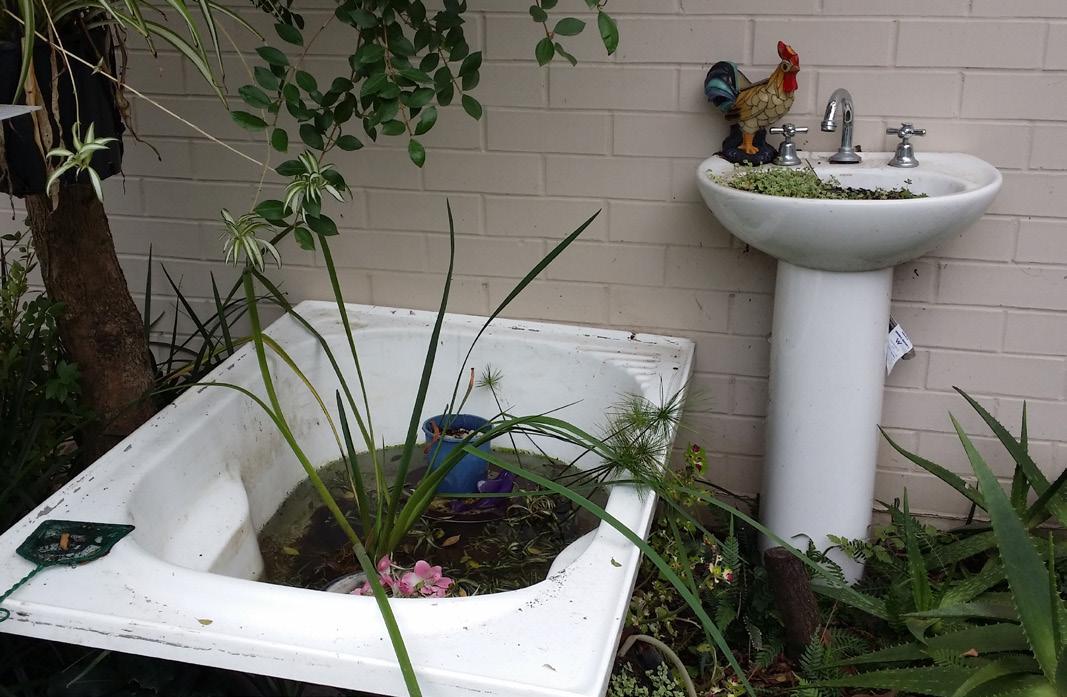
Repurposing, swapping, bargain hunting can help you create a garden on the cheap

 BY JYOTI SHANKAR
BY JYOTI SHANKAR
Recycling is a new concept but a very old idea. Our parents and grandparents always did it but there was no separate word to describe this. You can call it thrift, resourcefulness or jugaad (frugal
innovation, or making do with what is around). It all means the same - you make the best use of available materials and repurpose it instead of sending it to a landfill.
Sources of materials are op shops such as Salvos and Vinnies, free stuff picked up from friends, kerbside clean-ups and listed on websites such as Gumtree, Freecycle and Zilch. As they say, one man’s trash is another’s treasure. You can also get unique pieces for your garden at bargain prices on ebay.
As for plants, don’t be shy to ask for cuttings from neighbours and friends. Swap plants with friends. You will find that most gardeners are generous with seeds and cuttings. I often get plants from listings on Freecycle from people who are clearing overgrown yards. Join your local Permaculture group. You can learn from other members at meetings, listen to interesting invited speakers and you can swap or buy organic seeds from members for much cheaper prices than stores. Here are some examples of this from
our garden. Space is not a limitation, you are only limited by your imagination! Let’s inspire each other. Send us pictures and ideas of what you have done in your own homes, yards and balconies.
(Jyoti Shankar is a freelance writer and sustainability professional, who is passionate about nature. Her home garden is the laboratory for all things sustainable - recycled furniture, a worm farm, compost bin, veggie beds, a bird bath, native beehive, worm towers and more)

22 FEBRUARY 2018 www.indianlink.com.au
SUSTAINABILITY
Bath-tub & wash basin become fish pond and planter
Old wheelbarrow makes a great flowering plant holder
Scarecrow with old clothes and crutches found on the street







FEBRUARY 2018 23
Old kitchen utensil holder now holds a cascading ‘Dichondra silver falls’
Old terracotta pipes, sandpit timbers and clay snails create a cactus display
Vinyl record shaped into a planter
Broken strawberry planter reborn as cascading plant holder
Native beehive sits well on found iron table and discarded letter box atop
The broken part of plastic bucket cleverly hidden with a tilted display
A coat of paint makes this found wooden box as good as new
WHAT’S ON
REPUBLIC DAY
Indian Republic Day & Australia
Day Dinner
Sat Feb 10 (7:00pm to 10:00pm)
Australia India Society Of Victoria Inc is organising a function to celebrate Indian Republic Day and Australia Day, a musical event with gala dinner including 3 course meal, beer and soft drinks. (BYO Wines & Spirits).
Manningham Function Centre, 699 Doncaster Road, Doncaster. Details aisv.org.au
ENTERTAINMENT
Sanjay Dutt Meet And Greet
Sun 11 Feb (7:00pm) Bollywood singers, belly dancers, three course meal and drinks. The Melbourne Pavilion, 135 Racecourse Road, Flemington. Details Shinkoo NBH 0435 779 544
Bappi Lahri
Sunday 11 March (7:00pm) Palais Theatre, St Kilda. Details Rakesh 0411 621 371
STAGE
Sangeet Sandhya
Sat 3 Feb (7:30pm for 8:00pm start) Sharad Kala Kendra has invited artist Vijay Patki, a melodious singer

and accordion and harmonium player. Brandon Park Primary School, 1-5 Ninevah Cres, Wheelers Hill. Details Neeraj 0452 669 305
Hindustani Classical Recital
14 April (4:30pm-7:30pm)
Manmohini Events to present a classical vocal recital by India’s best known young female vocalist, Kaushiki Chakraborty. George Wood Performing Arts Centre, 84 Kalinda Road, Ringwood. Details girishbordawekar@ gmail.com
FESTIVAL
Lohri
Tues 13 Feb (6:30pm) 269, Robinson Road, Ravenhall Details Anu 0404 885 007
Sankranthi Sambaralu 2018

Sat 17 Feb (1:00pm-8:00pm)
Sankranthi Sambaralu 2018 organised by Andhra Aussies Association. Williamstown Town Hall. All are welcome. Free entry. Details Satish 0411 892 452
Melbourne Holi Festival 2018
Sat 24 Feb (11:00am to 7:00pm)
indulge in colours of India and groove on some fine tunes by International DJ lineup. Hosted by Holi Tribe Festival and IndoMystic. St Kilda Beach Victoria. Details 0469 393 460
HOPE IS LIFE
AIII Holi
Sun 4 March (11:30am-6:30pm)
Hosted by The Australian Indian Innovations Inc and Dr RnB Entertainment. Experience the fun of playing with powdered colour, water balloons for kids, dry powder Holi and water-based Holi. Scrumptious food by Melbourne’s most famous food trucks, children’s rides, variety stalls, nonstop music for all those dance lovers. Springers Leisure Centre, 400 Cheltenham Road, Keysborough. Details Raj 0411 429 598.
VCA Wyndham Holi 2018
Sat 3 March (11:00am-9pm) Hosted by Victorian Cultural Association Inc. Presidents Park, Wyndham Vale. Details www.vcaa.org.au
Festival of Colours 2018
Sun 25 Feb (11:00am-4:00pm)
Hosted by Harekrishna Valley. Barwon Park Mansion, 105 Inverleigh Road, Winchelsea. Details http://www. festivalofcolours.com.au/
Colorfest Melbourne
Sun 29 April (11:00am to 4:00pm)
Hosted by Star Event Productions. Moonee Valley Racing Club, 1 McPherson St, Moonee ponds. Details info@stareventproductions.com.au
Rang Barse - Festival of Colours
Sun 11 March (11:00am-6:00pm)
Monash Clayton Sports Center, Melbourne Details 0427 274 462.
Bundoora Park Holi
Sat 10 March (All day) Reserved Area, Bundoora Park. Details Pooja 0481 334 375
Holi at Werribbee Racecourse
Sat 3 March (11:00am-8:00pm)
An event by Festivals of South Asia Inc. Werribee Racecourse, 2-10 Bulban Rd, Werribee. Details www. festivalsofsouthasia.org.au
Holi Fair
Sun 4 March (11:30 am-6:30 pm)
The Australian Indian Innovations Incorporated’s event. Tatterson Park Cheltenham Rd, Keysborough. Details Raj 0411 429 598
COMMUNITY
Rajasthani event
Sun 25 Feb (7:00pm-11:00pm)
GNG Events is organising a dinner with a public talk from Aman Nath, and a traditional music performance by the Rajasthan State Awardee Samandar Khan Manganiyar and his Sampravaahi Group. Dinner will be three-course Indian cuisine. Crown Promenade, Queensbridge Street, Southbank. Details 0469 095 360
Sikh family camp
Fri 9 March to Mon 12 March This camp sees international facilitators coming to impart motivation, knowledge and Gurmat vichaar alongside local facilitators. Kids friendly. Camp Marysville 959 BuxtonMarysville Road, Marysville. Details 0431 692 299
MuslimFest
Sun 11 March (12:00pm-8:00pm)
Attracting over 10,000 people, this community event has been exciting residents of all ages and share the multicultural heritage of Islam with all Australians through art, culture, and entertainment. Highlights include carnival rides, free kids activities, cultural and community performances. Westgate Sports & Leisure Cnr Grieve Pde & Doherty’s Rd, Altona. Details 0432 175 822
SPIRITUAL
Saraswati Puja 2018
Sat 3 Feb (9:00am-5:00pm) Tarneit P9 College 21-23 Brinbrook Street, Tarneit. Details Nandini Sinha Roy 0433 858 448

FOOD
Foodie Trails - Indian Festival
Melbourne
Sat 24 March 9:00am to Sun 25 March 4:00 pm Queen Victoria Market, 452 Queen street Melbourne
MUSIC
Anoushka Shankar - Land Of Gold
Tues 13 March (8:00pm-11:00pm)
A singular figure in the Indian classical and progressive world music scenes, Anoushka Shankar grew up playing sitar alongside her father and Guru, the legendary Ravi Shankar. Arts Centre Melbourne 100 St Kilda Road Details 1300 182 183
MISC
Indian Women Business Network Meeting
Sat 3 Feb (6:30pm-8:30pm) Indian Women Business Network provides programmed networking exercises that helps its members and guests take steps to achieve their goals. Businesswomen of all ages from the Indian sub-continent from various industries and professions welcome. Mezzanine Cafe and Lounge 11/211 Leakes road, Truganina. A kidsfree event.
Valentine cruise party
Fri 9 Feb (7:30pm) Event hosted by Marvs Travel Group. Victoria Star Boat Docklands. Details 0425 795 135.
Women’s Day
Sat 3 Mar (5:00pm-9:00pm) Hosted by MDA Events, this project will have various competitions and challenges, meet and greet and general chat sessions along with dance and music performances. The project will be chaired by Filmfare award-winning actor Sangeetha Krish along with Harathi Ravindran (Aarthi), winner of Tamil Nadu’s prestigious Kalaimamani award. Hungarian Community Centre, 760 Boronia Road, Wantirna. Details Mandy/ Raj 0416 677 180
24 FEBRUARY 2018 www.indianlink.com.au
To list your event email: media@indianlink.com.au
IF YOU HAVE TROUBLES, I HAVE SOLUTIONS .. -,.,-�'"'...,.. ,A; x -_Q�-- _A_ Expert in Palm Reading, Face Reading, Numerology, Photo Reading, Horoscope and Lucky Numbers �i R #3 t+1 • t1@ •I 1� • :j il 1� M 1� @l•V4@ •I•)� 1 +1 =bid I PRIVATE & CONFIDENTIAL
FOR EVERY PROBLEM THERE IS A SOLUTION HEALTH PROBLEM MARRIAGE PROBLEM LOVE PROBLEM HUSBAND & WIFE RELATIONSHIPS CHILDREN MISTAKES EDUCATION PROBLEMS DIVORCE FAMILY ARUMENT FINANCE & BUSINESS SEXUAL PROBLEMS JOB & MONEY PROBLEMS JEALOUSY ENEMIES, ETC
VEDIC SOLUTIONS AVAILABLE FOR
Ushering reforms through education

Only well-to-do students would attend Kolkata’s Loreto Convent once. Then came Sister Cyril, writes SOMRITA GHOSH
She believes that education, not charity, is the only way to bring a change in India’s existing educational and social system. And to turn this thinking into reality, she battled the inequality in the classroom through pioneering school reforms.
This is the story of Sister Cyril, an Irish nun, who has been living in Kolkata for the past six decades. Her first impression was that the erstwhile Calcutta was a hot, humid and crowded city, but what moved her emotionally was the poverty and hopelessness of children dwelling in Kolkata’s numerous slums. And she had a different approach towards uplifting these slum dwellers.
“It struck me that we live in a layered society whose upper levels have little to do with the lower levels unless the latter come into the former’s houses as domestic help. It will be very difficult to change this system unless we bring all children from all backgrounds and mix them together on an equal footing. Only then will it be possible for us to have a fully integrated nation,” Sister Cyril said.
She remembered that when she began her experiment in 1979, there was hardly
any support from the local residents. In the same year, she took charge as the principal of Loreto Convent, Sealdah, an institute where mostly students from wellto-do families studied.
Questions were raised when she decided to open the doors of the school to slum children, but she was determined to bring about change in society through educational reforms. She fiercely battled the inequality in the classrooms and now Loreto has 50 per cent of its seats reserved for children from economically backward families.
“People said it couldn’t be done, I have proved that it can - by creating a school where all children are friends even though they belong to radically different backgrounds,” she maintained.
Not just this, but Sister Cyril, who recently co-authored a book titled Girls
Are Our Future - Thoughts of a Practical Radical Nun, has been the brain behind many social initiatives like Rainbow Homes, the Brickfields Project and Barefoot which helped tremendously in educating children belonging to the poorest sections of the community.
These 60 years have been quite a challenging journey for her. From landing in the then Calcutta in 1956 till now, Sister Cyril has seen many facets of the city - indeed, she has seen it changing. Not just infrastructural development, Sister Cyril believes that there have been many vital educational reforms brought in by the West Bengal government over the years. Now, she finds even the slum children carrying a school bag and walking towards a school. For her, this is a satisfactory improvement.
But there are still a few black spots that exist. One of these, she pointed out, was the marginal socio-economic development in the city’s slums.
“Very little improvement can be seen in the slum areas and in many cases the people are dislodged for high-rise buildings (to come up). The slum dwellers have been simply pushed to the outskirts,” the nun noted.
Kolkata has been a city that has been home to many missionaries and charitable institutions and with Mother Teresa, the city also learned compassion and empathy, but unlike her who believed in charity, Sister Cyril has always strongly believed in helping such children through education.

“We (Sister Cyril and Mother Teresa) had a good working relationship, she gave help to destitute people while I believed strongly in educating children so that they can get employment and support themselves to be independent,” she explained.
Asked if she ever thought of going back to Ireland, Sister Cyril firmly said no.
“Though some of my ideas would have been good for Ireland, there was no moment when I seriously considered going back,” she said, “except maybe in the very hot summer months of April and May.”
FEBRUARY 2018 25
INDIA DIARY
globalsistersreport.org
Photos:
It will be very difficult to change this system unless we bring all children from all backgrounds and mix them together
Muay thai fighter
 BY MITAL PAREKH
BY MITAL PAREKH

Watching Bruce Lee and Van Damme movies while sitting on your couch is one thing, but to play the role in real life is something else.
A two-time Muay Thai world title holder, Rav Sidhu is preparing to compete in the upcoming World Cup in March.

Muay Thai or Thai Boxing is Thailand’s martial art and a cherished cultural heritage that has seen a resurgence in recent times.
Developed hundreds of years ago as a form of close-combat, it uses various parts of the body as weapons. The hands are used like a sword, the shins and forearms as armour against blows, the elbow like a mace or hammer, the legs and knees like axe and staff. It is no wonder that it is sometimes referred to as “The Art of Eight Limbs”.
Rav’s love for this ancient Thai sport started at the very young age of 14 in 1992. 26 years of training and 32 fights in Thailand later, Rav is not planning to slow down in any manner.
So far, he has claimed a Lightweight World title in Bangkok, the Super Fight title and in October last year, the Lightweight Super League belt.
stadium promoters who saw me fight at a previous event, and he said he liked the way I fought, especially my aggressive walkup. I fought a very tough Thai opponent, Sorachart. He had a similar fighting style to mine. The first two rounds were fairly even, with both of us giving and taking some shots. The third round, the pace picked up and it was non-stop action; he got some strong knees to my body as he had longer reach than me. I just had to keep the right distance and work kicks to his body. In the fourth round, my trainer told me to change strategy and start to clinch. It was in the clinch I managed to cut him with an elbow just above his eye. The fight was put on hold as the doctor had a look at the cut. At this time I was hoping they would stop the fight as I was getting gassed due to the intensity of that round. Doctor said it was ok and the fight continued. I started to chase the cut and try and make it bigger and towards the end of the fourth round I managed to then knock him out with another elbow. I was thrilled to have won in the old Lumpinee stadium.”
Training for the fights comes with a strict diet and exercise regime for Rav. He usually likes to prepare six weeks before a fight with a high protein diet, clean eating and cutting down on carbohydrate intake. For exercise he does a lot of cardio from running to doing a lot of pad work. Back in Thailand he trains twice a day for two and half hours per session.
To add to his list of achievements, he has also been made the Australian representative of World Muay Thai Council. This puts him in charge of preparing an Australian team for the World Cup in Bangkok every year.
Having received his initial training here in Adelaide, Rav travels at least twice a year to Thailand to learn from trainers there as well. One of the major highlights of his career was a victory at the old Lumpinee stadium which has now been demolished.

“I was happy to be given the opportunity to fight at Lumpinee as it is the most famous Muay Thai fight arena in the world,” Rav told Indian Link. “I was approached by one of the Lumpinee
Muay Thai fighters usually have a nick name and Rav has been nicknamed ‘Soul Train’ by one of his trainers.
One of his strategies for winning fights is to go in as early as possible to knock out his opponent. This in turn saves him from five rounds of battering and come out with fewer injuries.
“I like to use all my weapons for fighting - kick, elbow, knees and punching. My favourite though is the left head kick with which I have knocked out a few opponents.”
A full time Muay Thai trainer now, Rav and his team at the club have helped train a few world champions and are currently training a few upcomers.
26 FEBRUARY 2018 www.indianlink.com.au
NEWSMAKER
I like to use all my weapons for fighting - kick, elbow, knees and punching. My favourite though is the left head kick with which I have knocked out a few opponents
A teenage passion becomes a way of life for Rav Sidhu
Challengers to the throne
BY RITAM MITRA
For some time now, many have proclaimed that an end to the long reign of tennis’s Big Four hegemony is nigh; with injuries to Federer and Nadal, followed by Djokovic and Murray, it seemed a mere formality that the next generation would finally usurp the powers that be. Yet a stunning 2017 renaissance by the oldest pair of the quartet saw those claims silenced; it was almost as if the rising stars were reluctant to extinguish the last embers of the trailblazing flames left behind by their idols.
At the 2018 Australian Open, that reluctance has, in a subtle sense, given way to urgency. It is most rare that three of the big four enter a slam and only one reaches the semi-finals. Although it was a very familiar face holding the trophy aloftwith no doubt now that the sporting world
has never seen an athlete of the pedigree, humility and longevity of 20-time grand slam champion Roger Federer - the way the tournament unfolded was proof: a change in the guard is now upon us.
In the lead-up to his truncated semifinal against 21 year-old South Korean sensation Hyeon Chung, Federer noted the wondrous uncertainty of playing, this late in a grand slam, someone about whom he knows so little. Indeed, as intimately as each fan knows and loves everything about their Big Four favourite, there’s a dearth of knowledge when it comes to the next generation - so we’ve picked out a few of this year’s rising stars who fans don’t know quite so well - for now.
Hyeon Chung (South Korea)

Ranked 58 going into AO2018, the inaugural Next Gen ATP Finals champion became a household name when he defeated his boyhood idol and former world number one Novak Djokovic in a stunning straight-sets fourth round upset. The first South Korean to ever reach a grand slam quarter final, let alone semi-
final, Chung only took up tennis as a way to improve his eyesight, having required glasses at a young age.
Although his glasses have now become a signature trait, it would be unfair to label Chung a cult hero; with his combination of movement, mental strength and power from both wings, he is destined for bigger things.
Dominic Thiem (Austria)
One of the few youngsters to use a singlehanded backhand, Thiem’s on-court flair is matched equally by his quiet and steadfastly private off-court persona. A strong baseliner, and the only player to beat Nadal during the Spaniard’s otherwise unblemished 2017 clay court season, Thiem has long been touted as one of the more exciting prospects in the tour, and has locked himself into the top 5 having already racked up 8 ATP titles, with over $10 million in prize money, to boot.

Yet, despite his undeniably abundant talent, the 24 year-old is yet to reach the quarter-final stage of a grand slam other than on his favoured clay. Having fallen in the fourth round to unheralded American
Tennys Sandgren, who was eventually brushed aside by Chung, Thiem will rue having failed to make a deeper run in AO2018.
Kyle
Edmund (Great Britain)
Yet another English athlete born in South Africa, Edmund took up tennis at the age of 10 after his exasperated mother attempted to burn off his excess energy on weekend mornings.


Britain’s number 2 began the year by beating two of the most exciting prospects on the tour in Chung and Canadian teenager Denis Shapovalov, and then backed it up with a stunning defeat of world number 3, Grigor Dimitrov, in the AO quarter-finals. In fact, if Edmund had reached the final, he would have overtaken Murray in the rankings - a feat that was unthinkable even a month ago.
With British number 1 Murray struggling to return from a debilitating hip injury, 23 year-old Edmund has finally given British fans hope of life after Murray, and may well eclipse his compatriot sooner rather than later.
Yuki Bhambri (India)

This year marked the third time that India’s number one player qualified for the Australian Open main draw, almost a decade since he won the junior title here in 2009. Having lost in the first round to Murray and Berdych in 2015 and 2016, Bhambri may have entertained hopes of finally recording a win having drawn fading Cypriot Marcos Baghdatis, but he was brushed aside in straight sets.
A child prodigy, Bhambri was the world’s top-ranked junior in 2009 at just 16 years of age. But if there were a story of unfulfilled talent, Bhambri would be it - with injuries halting his rise into the top 100, Bhambri’s body has so far prevented from reaching the heights that have long been expected of him.
FEBRUARY 2018 27
SPORT
While Federer proved why he’s regarded as the greatest, here’s a look at four young and exciting players from this year’s Australian Open 2018
Yuki Bhambri
Hyeon Chung
Kyle Edmund Dominic Thiem
Game, set, match!
Some scintillating moments from the Australian Open : the Indian challenge, top players in action - and Federer himself!

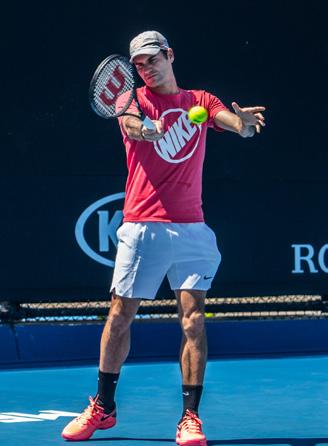
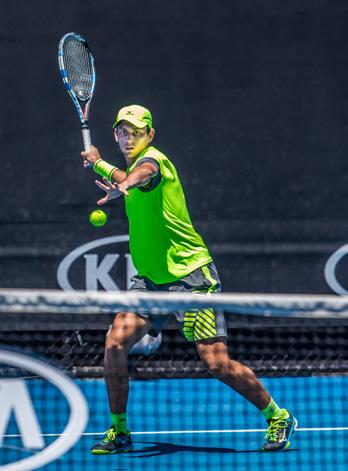
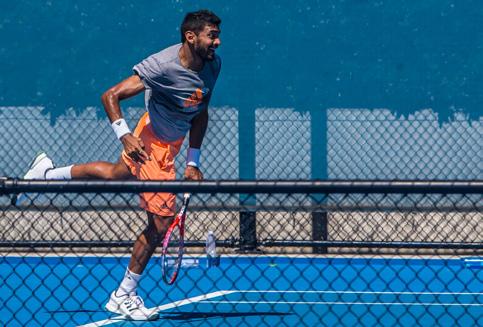

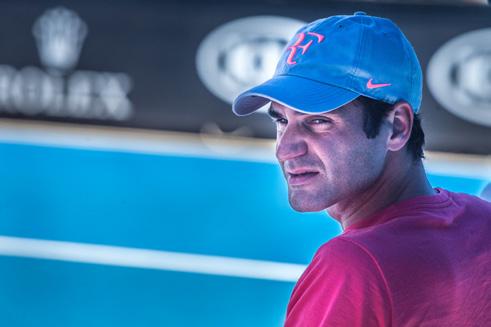

28 FEBRUARY 2018 www.indianlink.com.au
SPORT
Photos: Ravinder Singh Jabbal

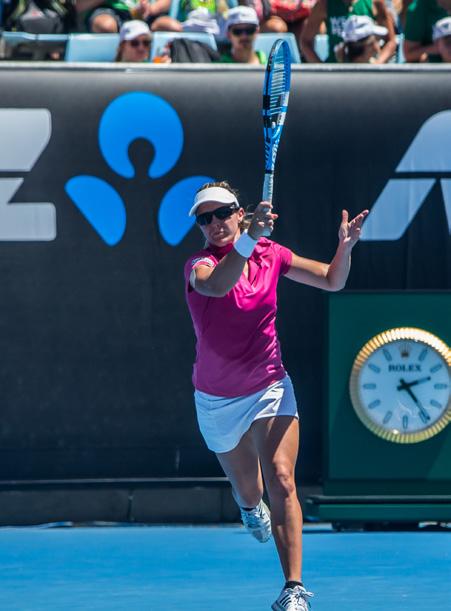
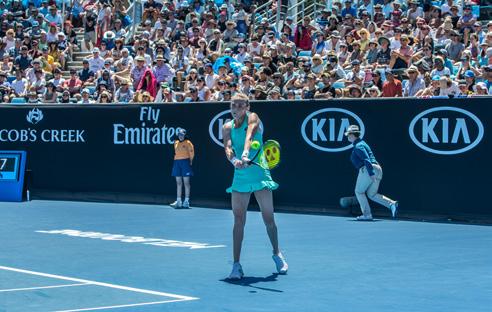
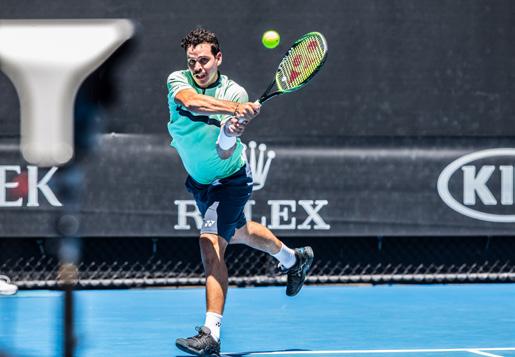
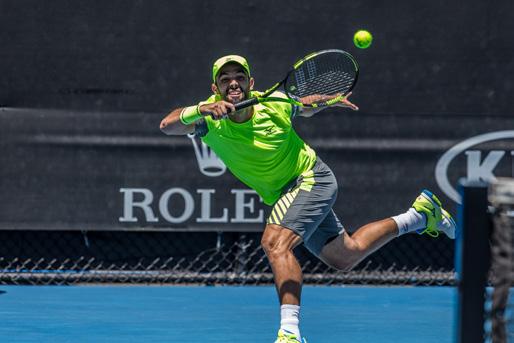
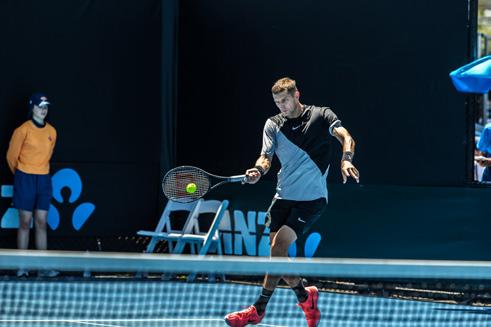
FEBRUARY 2018 29









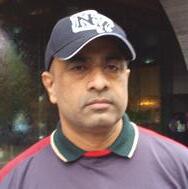
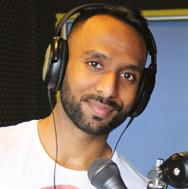
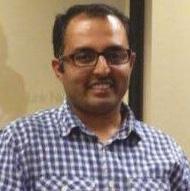



30 FEBRUARY 2018 www.indianlink.com.au Phone Safari Mail Camera Anup Neelam Raghu Manoj INDIAN INDIAN LINK RADIO Download the free App Now
Porous borders
Highlights from Multicultural Arts Victoria’s Mapping Melbourne festival in December 2017

Aboriginal artist/dancer Yaraan Bundle.
BY APARNA ANANTHUNI
Last year’s Mapping Melbourne festival offered variety in space, thought, and art forms. Notably, it allowed performers the space to present experimental work in intercultural fusion.
Serpent Dreaming Women
Conceptualised by Melbourne-based dancer and academic Dr Priya Srinivasan, this was an intense but meditative collaboration between Indigenous and Indian female artists.
Alongside Dr Srinivasan were Melbourne-based Carnatic singer and composer Uthra Vijay, world-renowned Bharatanatyam dancer Priyadarshini
Govind, and three Gundijtmara women: creative cultural artist Vicki Couzens, storyteller and visual artist Gina Bundle and language activist/traditional

A site-specific piece that was episodic, loose, and also space-specific, taking place in various inside and outside spaces of the Bunjalika exhibition at Melbourne Museum, this was a new type of collaboration across Indian, Indian diasporic, and Indigenous Australian cultures.
Serpent Dreaming Women wove together the artists’ biographies, autobiographies, traditional stories and texts, across rooms and environments. It employed a variety of contemporary storytelling and dance choreographies, as well as traditional performance modes.

In a panel discussion afterwards, all the women spoke of the surprising connections they had discovered between Indigenous Australian and Indian cultures, in language, mythology and the impacts of colonisation.
Hyper Fragility
Shown into the “Hyper Fragility Boardroom”, we sat at a long table while Candy Bowers and Victoria Chiu took us on a journey of dark, intersectional
feminist comedy and questioning of whiteness, colonialism, and nationalism.
Theatrical, with lightening costume changes, sharp choreography, and using sound, light, and audio-visuals, Hyper Fragility made me want to cry, relate-rage, and laugh uproariously at the same time.
I was especially moved by Bowers’ fragile, tortured rendering of ‘Jack the Colonial Boy’ in a white petticoat that showed her naked body underneath, shaking and panting, evoking the misery, helplessness and forced sexuality of the female colonised.
Chiu’s prowess as a choreographer matched Bowers’ comedic style perfectly, and the conclusion, with Bowers and Chiu cavorting gleefully on the table in wife-beaters, sunhats and ocker accents, shaking and throwing back beers, left us dazed, excited, with more questions than answers. Just as the artists intended.
NIDA Nights: Resonant Lines
An intimate showcase at The National Institute of Dramatic Arts’ studios in Southbank, two of ‘Resonant Lines’ performances were especially moving:

‘Tincture’ by Aarti Jadu and ‘Syllables of Ritual’ by Nithya Iyer, Luna MrozikGawler & Devika Bilimoria.

Jadu’s ‘Tincture’ was a beautiful wash of invocation to daily sounds, combining Western harmonics and violin with a Hindu prayer to the goddess, layered over with the sound of tea-making and dishwashing. It felt like a complete world of sound, and was the kind of intercultural ‘fusion’ that needed no explanation or indeed showed any ‘seams’ between the different music forms.
‘Syllables of Ritual’ was a mesmerising movement and spoken word piece with a musical backdrop, exploring the connection, contradiction, and complications of cultural heritage and inherited forms of worship, and the performers’ contemporary longings for and rebellions against both. The spoken poetry was laden with rich images of past and present, while the repetitive, meditative steps were hypnotic. The performers’ interruptions of each other’s poetry with humorous, natural discussion, was an interesting way to combine performance and analysis within the same piece.
FEBRUARY 2018 31
ARTS
Serpent Dreaming Women
Hyper Fragility
NIDA Nights
Photos: Damian
W Vincenzi
Beyond the Hindutva debate
Why I Am A Hindu by Shashi Tharoor. Aleph Book Company, 2018

Shashi Tharoor’s new book on Hinduism - the religion followed by a majority of Indians - comes at a crucial juncture when there is an upsurge in fringe elements that practise and propagate the ideology of Hindutva. The book, therefore, was being thought of as Tharoor’s response to Hindutva. However, limiting Why I Am A Hindu to the debate between Hinduism and Hindutva will be a grave injustice to this riveting offering as the book is much more than the sum total of this debate.

At the onset, it is a layman’s account of his journey of discovering the “extraordinary wisdom and virtues of the faith” that he has practised for over six decades. Tharoor himself makes it clear in the Author’s Note that he is neither a Sanskritist nor a scholar of Hinduism and, thus, did not set out to write a “scholarly exposition of the religion.” The book comes across as the author’s attempt to understand the religion that he follows; calling it a self-discovery of sorts will be accurate. Tharoor’s exposition travels between personal accounts and his understanding of the religious scriptures as well as the values propagated by the likes of Swami Vivekananda, Ramakrishna Pramahamsa and others in the league whom he refers to as the “Great Souls of Hinduism.”
It is thus imperative for the reader to have a clear state of consciousness before setting on to read the book because more
than anything else, it is about Hinduism, a religion, and religions are, after all, the reason behind most conflicts.
The book is divided into three sections, the first of which is titled “My Hinduism”. This answers the question raised by the title of the book: Why I Am A Hindu? Admitting as sincerely as is expected of a liberal intellectual as Tharoor, he sets the record straight and confides that he is Hindu “because I was born one,” and goes on to elaborate that religion is selected for most people at birth, “by the accident of geography and their parents’ cultural moorings.” But this analogy is not to suggest that he is not a proud Hindu. “I was never anything else: I was born a Hindu, grew up as one, and have considered myself one all my life.” The section talks at length about Tharoor’s early days, highlighting how his personal understanding of the religion developed with time. “My Hinduism was a lived faith; it was a Hinduism of experience and upbringing, a Hinduism of observation and conversation, not one anchored in deep religious study,” he points out. The section also explains at length what he calls “My Truth,” where he describes the reasons why he is “happy to describe” himself as a “believing Hindu”, before going on to present a fair perspective on the values propagated by the “Great Souls of Hinduism.”
The second section is titled “Political Hinduism” and this is where Hindutva comes into play. It is interesting to note that the author takes 140 pages (about half of the book) to reach to the burning
debate of our times and in doing so, he succeeds in providing a background on his belief of the religion, supplemented by the values propagated by the likes of Swami Vivekananda before explaining Hindutva. He begins this section by providing a clear distinction between Hinduism and Hindutva. For Hinduism, he presents an imagery of a banyan tree, in whose shade, “a great variety of flora and fauna, thought and action, flourishes.” From here, he moves to the Rashtriya Swayamsevak
It is from page 183 of the 302-page book, that he unleashes a storm of arguments on “the politics of division” that has led to “a travesty of Hinduism.” Next, the author eloquently elaborates on the uses and abuses of Hindu culture and history in the contemporary scenario, resulting from “the politics of division” that he earlier mentions.
The 28-page-long last section of the book is all that he spends on addressing what most would have expected from the
Sangh (RSS), the Vishwa Hindu Parishad (VHP) and its ideologues - Vinayak Damodar Savarkar and MS Golwalkar, explaining their perspectives on Hindutva. Using original quotes, he mentions Savarkar’s assertion, “Hinduism is only a derivative, a fraction, a part of Hindutva.” The book then moves, at an incredible pace, to the advent of Deen Dayal Upadhyaya and the Bharatiya Jana Sangh and then to the Bharatiya Janata Party.
Tharoor then devotes 40 pages decoding the philosophies of Hindutvanot as he perceives it but exactly how its ideologues propagated it. Contrary to all expectations, he does not criticise them or counter their views, at least at this stage.
entire book, “Taking Back Hinduism.” Beginning with a reference to former US President Barack Obama’s speech where he mentioned that “India will succeed so long as it is not split along the lines of religious faiths,” he elaborates on the “travesty of Hinduism” in the contemporary times.
Tharoor is brutal in his criticism of the saffron brigade but equally accommodating when it comes to presenting their views.
Why I Am A Hindu is a well-researched exposition and is yet a charming personal account - and it floats seamlessly in rich prose and diction synonymous with one of the most widely-read and revered authors of our times.
32 FEBRUARY 2018 www.indianlink.com.au
Shashi Tharoor ’s new book is a self-discovery of a ‘believing Hindu,’ writes SAKET SUMAN
BOOKS
For Hinduism, (Tharoor) presents an imagery of a banyan tree, in whose shade, a great variety of flora and fauna, thought and action, flourishes
Grilled to perfection
An Indian twist to the Australia Day barbecue tradition
BY DHANYA SAMUEL

Summer has been pretty intense this year, hasn’t it?
But that hasn’t stopped our love for backyard barbecues. After all,
what can be more fun than chilling out with family and friends, a couple of beers and some delicious food.
When you talk about grilling, tandoori chicken cannot be far behind - a dish that needs no introduction at all. It has become a global favourite and has staunchly become the face of Indian cuisine in most countries, apart from the curry of course.

Even though most of us might not
have a traditional tandoor at home, it’s quite easy to prepare tandoori fare on a barbecue grill, oven or even on a stove top grill depending on the kind of protein or vegetable that is being cooked.
I always make the tandoori marinade from scratch. Not a big fan of store bought masalas and moreover, the marinade is super easy to make. Many versions call for the addition of gram flour but using only yoghurt imparts more flavour without that
doughy taste to the coating.
For this dish, I have used the tandoori marinade for both the chicken thighs as well as the vegetables. While I cooked the thighs on a barbecue grill, I used a regular stove top grill for the veggies. Couscous pairs beautifully with a dish like this; its light and fluffy texture is a perfect accompaniment to the chicken and veggies. And a drizzle of the tangy mint coriander chutney completes the dish perfectly.
TANDOORI CHICKEN WITH GRILLED VEG AND COUSCOUS

TANDOORI MARINADE
Ingredients
1 ½ cup thick yogurt
¼ tsp turmeric powder
2 tsp red chilli powder (adjust to heat preference)
1 tsp Kashmiri red chilli powder
½ tsp coriander powder
¼ tsp garam masala
1 tsp cumin/jeera powder
¼ tsp black salt/kala namak
½ tsp chaat masala
¼ tsp dry ginger powder
Salt, to season
2 garlic cloves; grated
1 inch ginger; grated
2 tbsp fresh coriander leaves; finely chopped
Method
In a bowl, add all the ingredients and whisk well to get a smooth consistency.
CHICKEN
Ingredients
5 chicken Maryland/thighs; score
lengthwise
1 cup tandoori marinade
Salt to season
Vegetable oil, for barbecue
Method
In a bowl, add the required tandoori marinade to the chicken thighs. Season with salt (remember, the marinade has salt) and rub the marinade well into the chicken. Keep refrigerated for at least 4 hours, preferably overnight. Bring to room temperature before grilling.
Fire up the barbecue and grill the chicken pieces till done.
GRILLED VEGETABLES
Ingredients
1 red onion, cut into cubes
1 red bell pepper, cut into cubes
1 medium zucchini, cut into cubes
1 punnet baby corn
1 small broccoli, florets separated
1 small fennel bulb, cut into cubes
½ cup tandoori marinade
Salt, to season
Vegetable oil, for grilling
Method
Place all the vegetables in a bowl, add the marinade and season with salt if necessary. Mix well and keep for at least 1-2 hours.
Heat a stove grill to high, brush with oil and grill the veggies in batches. Remember to grill on high to get the char but still keep the crunchy texture.
COUSCOUS
Ingredients
2 ½ cups couscous
2 ½ cups water
Salt to season
Method
Add 2 ½ cups boiling water to 2 ½ cups couscous (1:1 ratio), season with salt, cover and keep aside. After 10 minutes, use a fork to lightly fluff up the couscous.
Note: Do check packet instructions as the ratio of water to couscous can sometimes vary.
FOR GARNISH
Lemon wedges
¼ cup coriander leaves; finely chopped
To assemble
Place the couscous in the middle of a large platter and arrange the grilled veggies around it. Garnish with half of the coriander leaves.
Place the chicken thighs on another platter, garnish with coriander leaves. Serve with lemon wedges and mint coriander chutney.
FEBRUARY 2018 33 FOOD
Cruise, Caribbean and Cuba

Experiencing the three Cs can be described as
another C-word: Charming
BY SANDIP HOR

Iticked off three items from my bucket list, all starting with ‘C’- Cruise, Caribbean and Cuba - when I recently voyaged the Caribbean Sea aboard luxury vessel MSC Opera.

MSC Cruises offers this 8-day schedule, which starts and ends at the Cuban capital Havana, providing ample opportunity to explore Cuba and its life, fall in love with the beauty of the Caribbean and get indulged by the on-board life on the sea.
Cruise odyssey
This was my maiden venture on a luxury ship, and so stepping inside the 65,591 ton and 274.9m long MSC Opera was like a happy exploratory mission for me. Despite its advanced years, the liner strikes as pretty appealing and modern, reflecting Italian and Mediterranean touches in décor. While the lobby and the reception create the first impression of a luxury abode, the rest of the features and facilities assure guests a grand experience.
The medium-size ship has 13 deck levels, each named after a celebrated opera like La Traviata, Rigoletto and Otello, accommodating 2,679 guests in their 1,075 cabins. Amenities include minibar, a safe, wardrobe and satellite television. There are over 700 crew members to look after guests and make their odyssey as comfortable as possible.
Life on the ship is different to that on land, but MSC Opera has almost everything contained within its hull, so that nobody misses anything. The on-
board facilities include shopping outlets, duty free goods, library, several bars and lounges for socialising to even a disco, casino and a cigar room where connoisseurs gather to sample the best Cuban and Dominican cigars with cognac. The ship also has dedicated play areas for the children to make this cruise suitable for a perfect family vacation.
Fine dining is always a highlight of any cruise and this ship is no exception. There are four restaurants which serve gastronomical delights of all kinds, though Italian cuisine gets a bit of upper hand, considering the Italian roots of the cruise line. While La Caravella and L’Approdo offer elegant fine dining, a huge international buffet is offered at the Le Vele venue for breakfast, lunch and dinner. The last one, Il Patio, is open for pizzas and burgers for almost 24 hours.
And to shed off the extra kilos gained from various culinary indulgences, the ship is well equipped with a modern gym, swimming pools, jogging track, spa, massage and sauna facilities.
There is no shortage of things to do on board, thanks to the wide variety of state-of-the-art leisure and recreational facilities, the main drawcard being Broadway-style shows, such as Romeo and Juliet and Lipstick at the plush theatre Teatro dell’Opera which can seat over 700 guests.
One of the great appeals of a cruise holiday is that without a lot of unpacking or changing rooms and bed, it’s possible to explore a new destination every day, generating a great interaction between land and water.
After leaving Havana and one full day at sea to enjoy endless blue of the Caribbean Sea, the ship touches shores of Belize, Honduras and Mexico for some exiting
excursions that showcase the culture, history and natural wonders of the region.
Caribbean splendour
The moment the word Caribbean is uttered, images of turquoise blue sea surrounding sun-kissed islands come to mind. That’s exactly what I encountered while cruising the Caribbean Sea, quite similar to the panoramas seen on TV.
The first stop - Isla de Roatan - is the largest of the three Bay Islands of Honduras. Once ruled by Spanish conquistadors and British pirates, this small island, 50km long and barely 4 km wide, is surrounded by stunning coral ridge, said to be second best to the Great Barrier Reef. It’s the ideal place for those looking for a perfect tropical vacation with plenty of aqua-oriented things to do
such as diving, snorkelling, swimming and kayaking and even rainforest walking and zip lining. Or you could simply relax at a beach with a book to read and rum-fueled cocktail to sip.
Next comes Belize City, where every day several cruise ships bring in over 15,000 visitors to give them a taste of Belize, the only country in Central America with a British colonial legacy and the largest barrier reef in the Western Hemisphere. The Calypso Train Tour is the best way to explore within a short time the colourful sights, sounds and history of this settlement, once packed with white colonisers and their slaves. The landscape displays a delightful blend of old and new. The most touristy site is the St John’s Cathedral and the Swing Bridge, which is said to be the only manually operated bridge of its kind in the
34 FEBRUARY 2018 www.indianlink.com.au
TRAVEL
world still in operation. Many of the city’s businesses are owned by people of Indian origin who were brought by the British during colonial times.

Ruins of Maya Empire, which enjoyed its heyday between third and tenth centuries, are a great lure for any western Caribbean journey and this cruise schedule allows to sample some of them when stopping at the ports of Costa Maya and Cozumel in Mexico, before returning to Havana. Built in a stepped pyramid shape, the temples and palaces in Chacchoben and Kohunlich in Costa Maya and Tulum in Cozumel testify the extraordinary artistic talents of the Mayans.
Cuba calling
Cuba for years has been like a forbidden fruit. So craving for the destination has always been enormous among savvy travellers. As a result, with doors now open for visitors, it has emerged as one the most sought-after destinations on the tourism circuit. Though famous for cigars, rum, Castro and the big and colourful American cars, the socialist nation has lot more to offer beyond these stereotyped Cuban images. Perhaps the most appealing feature is its cultural eclecticism which integrates centuries of colonial history, darkness of slavery, pomp and grandeur of the American influence and elements of the revolution. Capital Havana provides an amazing insight into all of these.
The 500-year-old city at present appears time worn and dilapidated, but the imposing buildings, hilltop citadels, grandiose squares and cobbled streets harken back to the glory days of old.
Most of these historic buildings, estimated to be around 900, are located around plazas in the old part of the city, called Habana Vieja. While the Cathedral de San Cristobal de la Habana is unquestionably the architectural showstopper, there are old palaces, mansions and churches in every corner. The ambiance is electrifying, filled with the aroma of cigars and beats of pulsating music that combine Spanish guitar and African drums.
No visit to Cuba is complete without an insight into its revolutionary chapter dominated by legacies of Jose Marti, Fidel Castro and Che Guevara. Havana is filled with statues and billboards of them, but the best place to know more about the revolution and the lives of these three revolutionaries is the Museo de la Revolution. This historical repository resides inside the earlier Presidential Palace, not far from the Capitolio Nacional, former seat of Cuban Congress, built during post WWI sugar boom, replicating Washington DC Capitol Building. Many ride an American Cadillac to go between the two iconic sites, just to tick off the ride in one of those cars which perhaps can now be found only in automobile museums.
TRAVEL NOTEBOOK CARIBBEAN / CUBA

GETTING THERE
Fly Qantas (www.qantas.com) to Lima in Peru with change of aircraft at Santiago in Chile and then TACA Airlines (taca.alternativeairlines.com) to Havana.
HAVANA STAY

At the centrally located, 178 room, Mercure Sevilla La Habana (www. mercure.com), where many famous people have stayed since 1908.
CUBA VISA
Australian passport holders need a 30 day, single entry ‘tourist card’ which can be obtained from the tour operator or the airline flying to Cuba; alternatively from Cuban Embassy in Canberra


MONEY
The currency for outsiders in Cuba is Cuban Convertible Peso (CUP). Rate is 1 Euro = 1.13CUP
FEBRUARY 2018 35
Cuba’s most appealing feature is its cultural eclecticism which integrates colonial history, grandeur of the American influence and elements of the revolution
Clockwise from top left: MSC Opera; on-board entertainment; Belize city; Cadillac cars in Havana; island of Raotan; Havana skyline; Havana streetscape
MATRIMONIALS
SEEKING GROOMS
Looking for match for Young, Unmarried girl, 31, born and brought up in Sydney with Hindu Indian family, working as teaching professional with NSW Govt in Sydney. Boy must be Educated Professional born, brought up in Sydney. Please call 0425 333 990.


Seeking match for a well-settled, beautiful, slim, divorced, professionally qualified girl from Rajput family. 46 years old (look much younger). Australian citizen, own house. Send your details and a photo on indsyd09@gmail.com
Seeking a suitable alliance for our daughter, she is 30 years old Hindu Brahmin. Born and raised in Australia living on the Gold Coast. Working for an Accounting firm, we are seeking someone that is also Hindu and preferably Brahmin. Funny, caring and respectful with a good education. Seeking someone who is born in Australia or has been living here for numerous years, someone with a good education and who shares the same values. Please email krishan11radha@ gmail.com
We are a well settled Jat Sikh family living in Australia and are seeking a professionally qualified match for our 5’2’’, slim, fair, attractive, 30-yearold daughter working as a lawyer in Queensland. Caste no bar. Please contact Hardev3058@gmail.com
Seeking professionally qualified settled



match for Sydney-based, never-married Australian citizen, Hindu, Punjabi Khatri 45, 5’3’ slim, fair, attractive girl. Girl is postgraduate and is working on a good position in government organisation. Please send details with photo to indsyd2016@gmail.com.
Seeking professionally qualified match for attractive 27 year old, 5’3” Punjabi Hindu Saraswat Brahmin BAMS doctor girl. Currently living and practicing in Chandigarh. She is passionate about her work as an Ayurveda doctor and enjoys traditional Indian culture. Looking for well settled, educated, non-drinker and nonsmoker Punjabi Brahmin boy in Australia or India. Please send details with photo to yoginder.sharma18@gmail.com
SEEKING BRIDES
Seeking a suitable bride for an Australian citizen, Sikh boy, 42 years old (looks younger), 5’ 8 ½” with wheatish complexion. Family settled in Australia. Innocent divorcee after one-month marriage. The girl should be 34-38 years old with family and cultural values. Caste/religion no bar. Please email biodata with recent full length photograph to pleasecommunica8@gmail.com

Match for very handsome Brahmin boy. 6’, very fair, MBA. Works as an analyst in a telecom company. Previous marriage was annulled in four months. Family in Australia & India. MP father and mother is a professional.
We offer catering services for all occassions:
• Birthdays, • Weddings,
• Corporate Events • Puja / Langar
We cater from 20 to 2000 guests and we suit your budget, taste and requirements.


36 FEBRUARY 2018 www.indianlink.com.au
FEBRUARY 2018 BY MINAL KHONA
Minal Khona has been reading tarot cards for the last two decades. She uses her intuition and connect with the cards mostly to help people.


ARIES
March 21 - April 19
This is a time for introspection and uncertainty. What takes centre stage is family matters, your significant other, health issues etc. An unexpected appearance of an old friend, lover or business associate gives you much joy; you will enjoy socialising this month. Be diligent about any paperwork and don’t rush through it. Pressure at work builds up because you are taking on more than you can handle. Conflicts at work will get resolved amicably; be on guard regarding office politics.
LEO July 21


You are in a creative state of mind and feelings, emotions, intuition rule this month. Something is missing as you long for love, affection and a deeper connection with someone. Relaxation, travel and the outdoors beckon. If trying to conceive, now would be a good time to plan a baby. Patience in financial matters is recommended for success. You will no longer accept what is counterproductive and take steps to change it. Don’t let distractions affect you at work.
SAGITTARIUS

Nov 22 - Dec 21
TAROT
TAURUS April 20 - May 20

The focus is on material aspects and physical well-being; mortality and spirituality. If in the initial phases of a relationship, remember that familiarity breeds contempt, so keep a distance and don’t rush anything. Some personal issue brings you despair and you might even consider ending a relationship as it is going nowhere. Avoid drinking or smoking too much. You might have to let go of a project due to a health condition. An offer of employment is on the horizon.
VIRGO
Aug 23 - Sep 22
You need to flick that off button and detach from stressful situations. Setbacks drain you and you feel burnt out. Some Virgos will seek a real relationship and may even consider ending an unhappy marriage. Emotional attachment to a situation will end and you will take charge for your own wellbeing. Constipation or haemorrhoids take you to the doctor. Be assertive in financial matters. A significant male in your life could be the reason for a major let down.
CAPRICORN

Dec 22 - Jan 19
A debilitating illness, business disagreement or an emotional issue could cause a loss of income or job. A short trip improves things for the better. Travelling overseas is also possible as is a journey for health reasons. Concentrate on the present. The work environment improves if there are hurdles. Money is tight but an increase in income is predicted. Headaches and tummy issues could be bothersome. If there are family problems, they don’t go away completely but tensions will ease.
GEMINI
May 21 - June 20
Home improvement is on the cards. You may receive a new business proposal but chances are you will reject it. There could be some turbulence in your relationship, but it is temporary and everything will work out. Take a break from stress, work and other worrisome matters. Negative conditions will clear up on all fronts and something better will come along. Your success will come from venturing away from original plans or ideas. Any delays that happen are in your favour.
LIBRA

Sep 23 - Oct 22
Move ahead despite fears, doubts and confusion. A new romance or a potential love affair with a charmer is on the cards. Unexpected problems are a blessing in disguise and the solution will improve on the original concept. You could buy something major for the house. Work gives opportunities to mix business with pleasure. Your energy levels swing high and low; watch your health during the low times. Any kinks in a tense situation need to be ironed out.
AQUARIUS


Jan 20 - Feb 18
CANCER June 21 - July 20

Work, success, financial security, obstacles in romance and anxiety take the front seat this month. Logistics, distance or priorities cause anxious moments in a serious love affair, but they can be overcome if you want to be together. A financial opportunity lands at your doorstep. Any health condition you have may need medical attention immediately as it could get painful. An unexpected inheritance, new car or job could come your way too. Be honest with yourself at all times.
SCORPIO

Oct 23 - Nov 21
Your intense and secretive nature might cause health issues that are entirely stress-related. So stay calm and balanced and if there are internal conflicts going on in your head, they will end. A positive change is in store and you will find a solution to an ongoing problem. If you are feeling stuck in a relationship, you might have a change of heart and decide to end things. A social event could be the buffer that provides clarity.
PISCES

Feb 19 - March 20
A Taurean influence makes you inclined to be even more practical, patient and security minded than you usually are. There could be unexpected developments in matters of the heart. A break-up is not likely and misunderstandings get resolved. Plans to travel may fall through. Don’t let emotional problems affect work; you could be considering taking on projects that take your career in a different direction. You could have problems with your teeth, gums or muscles. Straighten out financial matters.
You behave more like a Piscean this month as you channel your inner artist. There are feelings of dread and disillusionment in a relationship. Conflicts at work require emotional control to master the situation. Someone close may let you down leading to a huge disappointment. Sleeping disorders, lumps and cysts could cause health issues. Things will end on a happy note but take the middle road as unforeseen changes bring new perspective. Due payments come in but you still feel short-changed.
A short trip or a change of residence is indicated. A change of routine and practical challenges lead to a new way of life that is emerging, so professionally and personally there is a lot to be finished. Helping others gives you joy; don’t waste time on an impossible relationship that is burdensome. You are taking on way too much responsibility and could feel run down or tired. Go for what you want but only after the course of action is clear.
FEBRUARY 2018 37
- Aug 22
foretell
cine TALK
Section 18C
A protection we cannot afford to lose
A BREATHTAKING HOMAGE TO VALOUR OF RAJPUTS
Australians value freedom of expression but laws against hate speech are still essential
A flourishing society also requires more than just freedom of speech; it requires security, stability, a just legal system and a vibrant economy.
BY mATT KeAN
Australia is a country of great diversity. You can see it in the faces of the people that you work with. You can see it in the restaurants that line the main streets of our towns. And you can see it in the variety of religious and cultural events celebrated around the country: Chinese New Year, Diwali, Hanukkah, Ramadan and Christmas to name a few.

feeling to their parts. Though they sing the same song from different scales, they are like the earth and sky never destined to meet.
Bhansali imparts a portentous potency to their conflict. Without coming face-to-face, the two actors convey an almost-unbearable dramatic tension.
A flourishing society requires more than just freedom of speech; it requires security, stability, a just legal system and a vibrant economy
The climax with all of the Rani’s female entourage fighting off the advances of Khilji by hurling hot coal bricks on him, is a reverberant homage to Ketan Mehta’s Mirch Masala
That is why freedom of speech is not absolute. In this country, it is criminal to disclose secrets which risk the lives of Australian soldiers. It is likewise a crime for a corporate executive to disclose market sensitive information to his mates. The law protects us from slander and protects privileged comments made to our lawyers.
Remember Naseruddin Shah’s moustache-twirling subedaar in Mehta’s film lusting after the feisty Sonbai (Smita Patil)? Bhansali’s Padmavati echoes Sonbai with heartening whoops of joy. The sequences at the end of the film featuring Deepika Padukone and a bevy of women all wearing flaming-red, will stay with you for a very long time.
However, the treatment of the Aboriginal peoples in this country stands as a chilling reminder that tolerance has not always been embraced. The Cronulla riots similarly reminds us how quickly what we have achieved can be put at risk.
As a society, we recognise that these restrictions do not hurt our democracy or way of life. Indeed, we understand that they are necessary to maintain it. And laws against hate speech are no less necessary, because racism and bigotry tear at the heart of our social fabric.
Padukone as the royal queen who ends up being the second wife of a neighbouring empire. A similar fate awaits Deepika in Padmaavat

While the conflict between the two wives in Bajirao Mastani was conspicuously contoured, in Padmaavat Deepika’s Padmaavati barely manages to interact with her husband’s first wife (played by Anupriya Goenka).
I am afraid Shahid Kapoor as Padmavati’s husband seems a little shaky in his attempts to counter Ranveer’s psychotic Khilji with regal restraint. He internalizes his character’s struggles to an extent where he looks bored at times.
The proposed amendments to Racial Discrimination Act were put forward on the basis that the current wording of Section 18C inappropriately constrains our freedom of speech.
It is Padmavati’s conflict with her invader and intended violator Allauddin Khilji which occupies centerstage in this rigorous drama of resonant historicity.
On many occasions the historical facts are tampered with for the sake of edifying the essential conflict between the Queen and her invader.
Deepika Padukone and Ranveer Singh bring an exquisite operatic duet-like
That section makes it unlawful to do an act in public which “is reasonably likely… to offend, insult, humiliate or intimidate another person or a group of people” if “the act is done because of the race, colour or national or ethnic origin of the other person”.
There is no doubt that freedom of speech is important but it is important because of the role it plays in our democracy. Freedom of speech ensures that when you or I go to the ballot box we can make an informed decision about who to vote for.
Racism and bigotry leave people feeling exiled in their own home. They do not improve the quality of public debate nor do they assist the wise completion of a ballot paper. They are insidious because they attack a person because of their identity; their heritage. They imply that a person is inferior because of who they are. They are hurtful, divisive and can lead to individuals and entire communities feeling unwanted, unvalued and second-class.
But there is no dearth of bravura in Padmaavat. While Ranveer and Deepika as antagonists rip the screen part, two other actors Jim Serbh and Aditi Rao shine in smaller roles bringing to their part as Khilji’s manipulative toy-boy and idealistc wife, a strong sense of a backhistory that belies the length of their roles.
Padmaavat is a work of illimitable splendour. The 3D format seems quite an unnecessary grandeur-enhancement device. When we already have so much to savour and imbibe, why hanker for more?
As a society, we recognise that restrictions on free speech do not hurt our democracy or way of life. Indeed, we understand they are necessary
Subhash K. Jha
Comments today can also revive memories of past wrongs. Unfortunately, few ethnic groups have been spared the pain of racially justified persecution. Examples such as slavery in the United States and the Holocaust are well known. In recent times, the world has seen genocides in Rwanda and Bosnia, while today in North Korea persecution is justified by racial supremacy.
our social fabric


Freedom of speech is necessary so that as a community, we can debate political ideas and so that individuals can have a say on decisions that affect them.
Section 18C ensures that everyone has a role to play in that debate.
Together, we have built a vibrant, rich and diverse society. A society not focused on the differences between us, but founded on the strengths our differences afford us. Section 18C stands, not as a threat to freedom of speech, but as a protector of the purposes which that freedom serves, and as a guard to an achievement exceptional in this time and rare in times before.
Matt Kean is the Member for Hornsby and




Parliamentary Secretary for Communities.
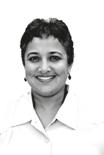
38 FEBRUARY 2018 www.indianlink.com.au entertainment
30 AUGUST 2014 www.indianlink.com.au
op I n I on
• Reliable Service and Privacy Guaranteed • Over 25 lenders to choose from • Commercial finance Health check for existing Home Loan are the same.... until I met Swati” – Komal Over 18 years of experience in finance industry. Talk to a qualified professional. Dandenong and Springvale Call Swati Palsule on 0411 78 28 18 Authorised Credit Representative 400349 of BLSAA Pty. Ltd. (Australian Credit Licence No.391237) Talk to a specialist for all your Home Loan needs There is no subs T i T u T e for experience. swati@buyerschoice.com.au INDIAN LINK SOCIAL MEDIA
KAALAKAANDI
CAST: Saif Ali Khan, Akshay Oberoi, Isha Talwar, Sobhita Dhulipala, Kunal Roy Kapoor, Vijay Raaz, Deepak Dobriyal, Shivam Patil, Shenaz Treasurywala, Nary Singh
DIRECTOR: Akshat Varma.
HHHHH
And as the title suggests, right from the first frame, we are reminded that nothing can go right for its characters. What makes Kaalakaandi interesting, though, is its dark comedy, easy to relate situations and characters. It is one of the easiest films to love and one of the hardest to think of as a work of art. It approaches the notion of pure filmmaking as entertainment. It lacks, a lesson or message and is

content to show three sets of people facing a series of interlocking challenges they face one night.
Set in Mumbai, with a variety of quirky characters awake after midnight, it reflects the unpredictable life in the city. But they seldom find themselves intertwined in a bizarre series of coincidences.
Boldly told, what happens to the characters apart from the nightmarish and bizarre nature of their experiences can only be described as screwball logic.
While the plot unravels like the pages of a thriller, the humour seems laboured. You witness this in the first scene and in the climax.
In the opening scene, Saif Ali Khan is in his doctor’s clinic where his doctor
TRIPPY, ENJOYABLE AND REVEALING
raided. How they escape from the clutches of the police and what fate has in store for them then unfolds into this thread’s narrative.
In the third narrative, Vijay Raaz and Deepak Dobriyal, work as flunkies for the local gangster. After collecting the protection money from a film producer, how greed overcomes them, forms the crux of their fate.
sugar coats his diagnosis with, “You do not suffer from ulcers, hence you don’t have perforating ulcers. Instead you suffer from stomach cancer.”
For a person who never experienced the excesses of life, this unpleasant bit of news hits like a ton of bricks.
So when he returns home, where the wedding preparation of his younger brother Angad (Akshay Oberoi) is underway, he sips alcohol and tries a narcotic substance. This sets the ball rolling for a roller-coaster cinematic experience.
In the second situation, Zubin (Kunal Roy Kapur) is in low spirits because his girlfriend is migrating to America. Just before her flight, as a farewell gesture and to celebrate the birthday of their friend Ann (Shenaz Treasurywala), they land up at a pub which predictably gets
A THRILLER UNLIKE ANY OTHER
VODKA DIARIES
CAST: KK Menon, Mandira Bedi, Raima Sen, Sharib Hashmi
DIRECTOR: Kushal Shrivastava
HHHHH
It isn’t often that we get to see a suspense thriller that dares to go that extra mile in pursuit of some novelty in a genre that invariably relies on cliché for effect.
Vodka Diaries is high on pegs of pungent potshots taken at the suspense genre. It defies the ground rules laid down by the architects of the suspense genre (whoever they might be) and deconstructs the entire edifice of intrigue into a cat-and-mouse chase which culminates in a frightening psychological disorder.
The film opens with an impressive severe topshot of a distraught KK Menon running through the snow of what we soon come to know is Manali. It’s a breathtaking shot and kudos to cinematographer Manish Chandra Bhatt. You suspect debutant director Kushal Shrivastava constructed the entire plot of suspicion and murder from this visually surcharged startingpoint.
Luckily for the debutant director,
and for us, the narrative suffers from no serious starter’s hiccups. It gets involved in its own complexities without losing track of the myriad characters’ motivations. The very talented KK Menon takes a bit of time to settle into the wheels-within-wheels that run through the narrative in scampering motions. But he soon settles down to a distraught destiny set aside for his character.
Mandira Bedi, an asset to any project, has a limited screen occupancy. And she makes the best of it. But after Menon, the actor with the best lines and moments is Sharib Hashmi. Last seen in Phullu, Hashmi chews eagerly on every scene provided to him as Menon’s sidekick.
Raima Sen, another beautiful and neglected actress, walks in and out of the proceedings as though shooting in bouts when on vacation. There are several such cameos in the plot. And I held my breath to see how the director Kushal Shrivastava and his writer Vaibhav Bajpai balance out the ostensible out-of-control plot about a cop who seem be losing control over the goings-on.
Luckily, the director never loses the plot as he manoeuvres the tricky
suspense through a maze of deception and delusion, on to a bumpy but safe landing.
Vodka Diaries is not a great suspense drama when compared with the Hitchcockian tradition. God knows, the genre has not been much explored in Bollywood. Still in its infancy the

What keeps the quirky characters afloat are the spunky, rustic dialogues that are gags by themselves. On the performance front all actors have put their heart and soul into their characters and they shine on screen. Unfortunately the characters are two-dimensional and cardboard thin. Of the supporting cast, Sobhita Dhulipala as Zubin’s girlfriend, Amyra Dastur as Angad’s fiancée Neha, Isha Talwar as the wedding photographer and Saif’s love interest, Treasurywala as Ann along with Shivam Patil as her boyfriend Jason who calls himself “Jehangir Jehangir” have their moments of on-screen glory.
Overall with good production quality, debutant director Akshat Verma’s attempt at this noir comedy is engaging but the script material tries to sell itself a little too hard.
Troy Ribeiro
whodunit gets a rather likable shake-up on this occasion.
Do stay for the end credits to hear Rekha Bhardwaj and Ustad Rashid Khan crooning Sakhi ri. It’s a sobering send-off to a suspenseful and original journey.
Subhash K Jha
FEBRUARY 2018 39
the BUZZ entertainment
UP-TO-DATE NEWS ON WHAT’S HOT AND HAPPENING IN BOLLYWOOD

NOT AS AMBITIOUS, GREEDY AS KHILJI: RANVEER SINGH
With menacing eyes, eccentric mannerisms and powerful acting, Ranveer Singh has upped his own ante as Delhi Sultan Alauddin Khilji in Padmaavat. But the actor says it’s a character whose ambitions and greed he does not relate to, even though he has his eyes on building a vast legacy of filmography to be proud of.
After captivating cine-goers with his powerful performance in films like Goliyon Ki Raasleela Ram-Leela, Bajirao Mastani and the latest Padmaavat, actor Ranveer Singh is set to dive into projects that are as different as chalk and cheese. There’s Gully Boy, Simmba and a biopic on India’s 1983 Cricket World Cup victory.
“I have a very large vision for myself, my body of work, my career. I hope to build a vast legacy with a filmography which I can be proud of when I am done. I want to look back and feel like I made a significant contribution to the art,” Ranveer told IANS recently.
With Khilji, Ranveer has achieved that. Where did the inspiration for his eccentric antics in the Sanjay Leela Bhansali directorial come from?
“There’s no references (for the character) as such and it definitely didn’t come from within. I cannot really relate to Alauddin Khilji at any level. I am not as ambitious, as greedy and as manipulative,” Ranveer said. Was it a risk to play the anti-hero?
PARINEETI: SELLING AUSTRALIA TO INDIANS
What’s the capital of Australia, we asked Bollywood star Parneeti Chopra on Indian Link Radio when she visited here last.
“Sydney,” she said bubbling over with characteristic enthusiasm.
The loud silence that greeted her answer gave her an inkling that something was amiss.
“Oh NO it’s Canberra, isn’t it! Can you please erase that answer!”
But that was over a year ago, and now Parineeti is a lot more confident in her role as “Friend of Australia”.
Snippets of her videos filmed then have now been released as an ad for Tourism Australia, as both India and Australia celebrate an important national day on 26 Jan.
“I thoroughly enjoyed my time in Australia and the videos reflect every bit of fun I had there,” the muchmore self-assured Parineeti said at
the launch in India.
“From immersing in the aboriginal culture at Uluru to the fun and frolic in Queensland, I was fortunate to have an enriching experience of two completely different sides of the country. It is undoubtedly a must-visit holiday destination,” she added.
In the films, Parineeti can be seen cuddling a koala, learning to surf at the Gold Coast, getting a taste of Australia’s freshest produce, enjoying a birds’ eye view of Surfers Paradise on the Skypoint climb, spotting whales, watching the sunset over the Red Centre in Uluru amongst others.

As an added bonus to Parineeti fans, the ad also features the bubbly star singing the background vocals.
But if you want to listen to Parineeti do an Aussie accent, or show off her knowledge about all things Australia, check out Indian Link’s interview with her on our YouTube channel.
“It was a huge risk. I was very apprehensive about taking the risk but Bhansali was very persistent in his pursuit of me and he is the one who convinced me that I would be able to pull it off. I went with his conviction. I can never say no to Bhansali, given the amount he has contributed to my career and to me as an artiste. Once I committed, I put my everything into it. But, yes, initially there were apprehensions.”
Ranveer has said he found the character “mentally, physically and emotionally” draining.
The movie was mired in a row as protests erupted over alleged distortion of facts. After the film released following a long-stretched battle, reviews pointed out at how Khilji’s character has been demonised.
HRITHIK ROSHAN: MATHS GURU
No thanks to the lessons learnt from Padmaavat, we’re suggesting caution to the unit of Hrithik Roshan’s latest project Super 30. Who knows, the academic world might follow in the footsteps of the Shri Rajput Karni Sena and protest against Hrithik’s role as a mathematician.
Apparently the hunky star plays Indian maths whiz Anand Kumar in the film. Mathematicians all over India, unite in protest… how can such a handsome hunk be good at maths??? Does Hrithik
know any maths?? Let’s get the best experts in the country to test him!
Meanwhile, the devout Hrithik thwarted any such attempts by seeking divine intervention, just like Deepika. He tweeted to the gods recently: “On the auspicious day of Saraswati Puja and Basant Panchami, I am beginning my journey of Super 30 where I am playing a teacher for the first time. May the Goddess of Learning bless this effort.” Super 30 is a biopic on Anand Kumar, who teaches 30 meritorious and talented candidates each year from economically backward sections for the entrance examination to the prestigious Indian Institute of Technology. The film is slated to release in November this year.
Stay cool, Hrithik, we’ll support you against fundamental mathematicians come what may – beheadings, selfimmolation…
3D COMEDY
Karan Johar, Diljit Dosanjh, Sonakshi Sinha, Rana Daggubati, Riteish Deshmukh, Lara Dutta, Boman Irani, Sushant Singh Rajput.
That’s the cast of a new comedy film coming up on 23 Feb, a 3D comedy no less, called Welcome To New York
Produced by Vishu Bhagnani, the movie tells the story of two unlikely youngsters living in India in search of a better life for themselves. An unexpected trip to New York City sets them off on a comedic adventure that changes their lives forever.
Worth waiting for? You decide!
DUTT’S THE WAY…
The Rajkumar Hirani-directed biopic on actor Sanjay Dutt has been wrapped up. The makers shared a special video on Twitter to announce the wrap-up.
Hirani, along with actors Ranbir Kapoor, Sonam Kapoor and other cast and crew members are a part of the video, in which they say in unison: “Dutt’s the way, aha aha, I like it, aha aha.”
Ranbir, who plays Sanjay Dutt’s character, is also seen popping the champagne, whereas Sonam takes to her social media page, sharing the happy moments while marking the last day of the shoot.
Ranbir will be seen playing the title role in the biopic. The film also features Anushka Sharma, Dia Mirza, Manisha
40 FEBRUARY 2018 www.indianlink.com.au
DEEPIKA PADUKONE
Koirala, Paresh Rawal and Vicky Kaushal.
Presented by Fox Star Studios, the yet untitled Dutt biopic is co-produced by Vidhu Vinod Chopra and Hirani and is slated to release on 29 June. Worth waiting for? You decide!
OSCARS 2018: DESI LINKS

Indian actor Ali Fazal-starrer Victoria & Abdul has two nominations and Anupam Kher starrer The Big Sick stands a chance to win in one category at the 90th Academy Awards this year.
Victoria & Abdul, a movie about a unique bond between Queen Victoria and her Indian Muslim servant Abdul Karim, has won a nomination in the Best Costume Design and Make-up and Hairstyling categories. In the film, Ali plays Abdul, with Hollywood veteran Judi Dench as Queen Victoria.
As for Anupam’s The Big Sick, it is nominated for the Writing (Original Screenplay) honour for Pakistan-origin
Kumail Nanjiani and Emily V. Gordon. The Academy of Motion Picture Arts and Sciences President John Bailey, announced the nominations this week via a global live stream. Bollywood star Priyanka Chopra was one of the celebrities who participated in pre-taped category introductions.

Newton, India’s official entry for the Foreign Language Film category, had failed to make the cut to the shortlist early in the selection process. Films from
Sweden, Chile, Lebanon, Russia and Hungary have made it to the final list.
The 90th Oscars, hosted by Jimmy Kimmel, will be held on 4 March at the Dolby Theatre in LA.
ANIMATED SERIES INSPIRED BY SINGHAM IN WORKS
Little Singham, an animation series inspired by Bollywood film Singham, is in the works.
Reliance Animation has been commissioned to produce the new disruptive Indian original content series, targeted at children in the age group of 4-8 years.
Little Singham will go live in April this year on Discovery Kids channel. It will be aired in four languages - English, Hindi, Tamil, and Telugu.
The series will set a completely new benchmark for animation in India. As many as 250 animation artists have been engaged on the project.
ART SHOULD NOT HAVE BOUNDARIES: KARAN JOHAR
Meanwhile, Karan Johar showed his serious side to the world fairly impressively this week. The filmmaker was attending the World Economic Forum Annual Meeting at DavosKlosters, Switzerland. Participating in a panel discussion, he said that art should not have boundaries and one cannot enforce culture to the people.

The filmmaker shared the stage along
with renowned cellist Yo-Yo Ma, Alice Bah Kuhnke, Minister for Culture and Democracy of Sweden and Arlie Russell Hochschild, Professor of Sociology at the University of California.
The panel was discussing the topic “Can we avoid the spread of so-called ‘culture wars’?”
Talking on the matter Karan said, “You cannot enforce culture or imbibe it. There are immense economic and social problems, but sometimes the main papers and politicians don’t talk about them because they are focused on a film. It’s empowering to the film industry, but it’s ridiculous.”
Recounting a time he was accused of being ‘non-Indian’ for casting a Pakistani actor in one of his films, Karan said, “Art should not have boundaries but then culture and patriotism is thrown at the artists.”


The panel discussed the virtues of tolerance.
While Alice Bah Kunke said that in politics, one needs to be very, very tolerant, Karan said “there is a risk that tolerating intolerance in others can be misconstrued as validation.”
The annual meeting was graced by some of the iconic Indian personalities, including Prime Minister Narendra Modi, business tycoon Mukesh Ambani, Bollywood star Shah Rukh Khan who received the Crystal Award that celebrates the achievements of leading artists.
WHAT TWEETY BIRD TOLD US THIS WEEK
Match the following stars to the tweets that appear below: Parineeti Chopra, Deepika Padukone, Shah Rukh Khan, Anupam Kher
Honoured to receive the WEF’s 24th Crystal Award, together with Elton John and Cate Blanchett. My fan moment!!
So excited to finally show you all my videos from Australia! Guess who sang the song?
Congratulations to Emily Gordon and Kumail N for the Oscar nomination for Best Screenplay for the The Big Sick. So proud to be a part of this gem of a film. Jai Ho.
Our tribute to the valour, legacy and courage of the Rajputs, Padmaavat releasing now on 25 January.
WIN MOVIE TICKETS!
What are DEEPIKA and RANVEER saying to SANJAY LEELA BHANSALI here?
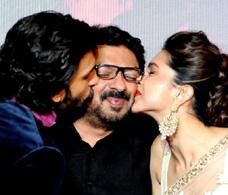
Send your response to: media@indianlink.com.au TO WIN A MOVIE TICKET!!
LAST ISSUE CAPTION CONTEST WINNING ENTRY
What’s the chitchat here between SAIF ALI KHAN and his son TAIMUR?
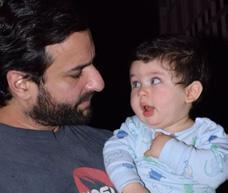
Leyla Singh: Don’t look at me like it’s bedtime.
Congratulations, Leyla. You win a movie ticket!
OTHER GOOD ONES: Taimur to Saif: Dad, I heard you are a Nawab and still have to work for a living?
Vishal Degaonkar
Saif: You can’t have a girlfriend until your 16 Taimur: Aghh but I already have one Kaamya Narang
FEBRUARY 2018 41
KENDALL JENNER or PRIYANKA CHOPRA in RALPH AND RUSSO?
your views with us on our Facebook page /IndianLinkAustralia
WHO WORE IT BETTER?
Share
CAPTION CONTEST
KARAN JOHAR
HRITHIK ROSHAN
RANVIR SINGH
ASK AUNTYJI
Good golly Miss Bolly
DEAR AUNTYJI
I am 40 years old and married to an Australian lady for the last twenty years. While I try to follow some aspects of my Indian culture, I have generally become Australianised. Of course, I still support the Indian cricket team! Now Auntyji, my wife - while she is a lovely lady - has mostly been ignorant of the Indian culture. We don’t have any friends of Indian descent, and all my relatives are in the US. So Auntyji, here is what happened a few years ago. One day, while I was watching cricket, my wife got angry and switched the channel to SBS where a Bollywood movie was playing. I don’t recall what it was - because I have not seen one Bollywood film, even when I was in India because my parents didn’t consider it high culture. But Auntyji, my wife was hooked. She and I had a massive argument. Since that day, Jennifer became hooked on Bollywood. She watches these films all the time, listens to Bollywood music and even when she is on the iPad, I can see her reading up on film stars. I don’t know what’s wrong with her, but she says she is imbibing Indian culture from watching these films. And slowly she is changing. She has made herself some new friends who are Indians who arrived here recently. She goes to every new Bollywood film that opens. And just the other day, she insisted that this year, she was going to keep Karva Chauth. Auntyji, when I heard this, I went on an automatic fast myself for the entire day.
I could not eat or drink. What has overcome of my poor ignorant wife? When do you think she will return to her old, ignorant, uncultured ways instead of trying to do an adaab whenever she sees an appa in a burka because that’s what happened in Mere Mehboob, or so I’ve been informed. Please advise, I am at my wits’ end.
AUNTYJI SAYS
Oh, you crazy, crazy man! You are such a philistine! Don’t you know that Bollywood is a key tool that the Indian diaspora utilise to understand who they are and where they came from? Today, if you go to Mauritius, South Africa, Fiji, Maldives or Malaysia, you will find people of Indian descent whose ancestors left India over a hundred years ago, and these folks watched Bollywood to learn about India and the traditions of its people. Bollywood has its place in society. It allows people all over the world to be entertained, amused, perplexed, flabbergasted and occasionally outraged by what they see and hear on the screen. They then try to emulate this in their lives - why else would brides insist on doing the saat phere when everyone knows it’s a Marathi custom, and why else are Fiji Indians now having a sangeet night at weddings - when this was never part of their culture. As for Ms Jen, she has seen the beauty of Bollywood. You should be happy that she is learning more about your peoplethere is nothing wrong with educating oneself. In fact, if I may be so blunt, it is you who is uncultured by looking down on an important educational tool. Something that has given people so much joy, happiness and understanding should
not be mocked. I suggest that you leave your wife alone, and instead go and watch a few Bollywood films yourself. You should start with Raj Kapoor films, because as everyone knows, this was the hey day of cinema. And then evolve to Amitabh Bachchan films. Jug jug jiyo.
DEAR AUNTYJI
I am an Australian girl and have started going out with an Indian man who is wonderful to me. I have had a strange experience I was hoping you can shed light on. A month ago, I met Neel’s sister and her husband and we decided to have dinner together. Afterwards, we went back to their place, and for some reason, Neel’s sister’s husband had done something to upset her. She was cranky with him, but the way he was trying to placate her left me gob-smacked. He started speaking to her like a little boy - and tried to get her attention and favour. He kept on walking to her and saying “suno nah” or something like that, but in a little boy’s voice. At one stage, he even grabbed her hand and tried to get her to look at him, shaking it as though he was six years old and had done something to upset his mother. Alisha, meanwhile, was hell-bent on ignoring him and was trying the silent treatment. I was so baffled by this perplexing drama going on in front of me, but not as much as I was all shook up when last week, Neel did something to
irritate me, and then tried the same behaviour with me! He kept on talking in a little boy’s voice, like a petulant little brat. And then, he started accusing me of not loving him and not caring for him because I wasn’t giving in to what he wanted. Auntyji, I am still in trauma from this ridiculous event. I don’t know many Indian people, but I need to know immediately if this is how Indian men are. When they are in trouble with their wives and girlfriends, do they carry on like little boys? And more important, how do I deal with this? My natural inclination is to tell him off, or walk out the door temporarily to avoid the horror of a fully-grown man regressing to an infant during moments of stress. But what do you suggest I do? I am all ears.
AUNTYJI SAYS
Oh, there are so many options available to you, my dear girl, that I do not know where to begin. You do not have to tolerate this rubbish for a second. But allow me to digress a little and tell you what I did when Uncleji tried this on me when we got married 55 years ago. Now Uncleji was the youngest of seven brothers, and as you can imagine, he was an absolute laadla. Family lore has it that he did not walk until he was five years old, because everyone carried him everywhere because he was cho chweet, cho precious. And would you believe, his mother, Rani Ma made him kheer every single day with her own two hands for the first seven years of his life, and fed it to him? Further, one day, in his youth, he came home from a shikar and fainted because he did not have anyone to
pour him a pitcher of water and he didn’t know how to do it himself? So you can see he was as cosseted as they come. Apparently this is normal nawabi behaviour. So one day, after we had gotten married, he did something to irritate me and then when I glared at him with my hirni jaisi aankhen, he threw himself on the ground and literally pounded the earth in a full fit of fury. My reaction was immediate. I was so surprised and incensed by this child-like behaviour that I drew myself up to my full five feet one inch glory, puffed out my chest, and hissed at him that if he ever behaved like a child again, I would talaq him on the spot! My face was red, I was quivering with rage and breathing like a witch on roids. That got his immediate attention. I then declared that I was going to take my favourite horse Sheru out for a ride and needed to be left alone, because I had never seen such despicable behaviour in a grown man. He never behaved like that again. So what do I recommend for you, my dear? Two options. Secretly record the event and then play it back and laugh uproariously at your poor paramour, and he will be humiliated enough never to try this again. Or, you could be mature about this, and do what I did. Give him a withering look, stare at him for 60 seconds, and with a dismissive and contemptuous tone, declare that if he behaves like a child ever again, the relationship is over. Tell him that you don’t find this attractive in any way, and if anything, it makes him repellant to you. It is just as annoying as women talking like little girls. It’s not cute. It’s disturbed. Good luck my dear Anarkali, let me know how you fare.
INDIAN LINK RADIO APP




42 FEBRUARY 2018 www.indianlink.com.au
(Desi) Men behaving badly
BACKCHAT


FEBRUARY 2018 43 NBN Bundle: Min Charge includes $10 Delivery + $20 Prepayment + $99.95 Setup. Available in selected coverage areas. Typical Evening Download Speed is measured between 7pm and 11pm. Actual speeds may be slower and could vary due to various factors. Prepayment automatically topped up if it falls below $10. Service barred if prepayment top up payment fails. Mobile: Min charge includes $10 SIM. New mobile registrations only. Unlimited Calls & SMS to Standard Australian Numbers are for use within AU only. Standard rates apply for other usage types such as Excess Data, International Calls & SMS, Video Calls, International Roaming & other Enhanced Services. Calls and SMS to 19 Numbers and Premium SMS/MMS are not supported. Data usage is charged per KB or part thereof. Excess Data $10 for extra 1GB blocks. Excluded or excess usage is only possible with sufficient Prepaid Balance. General: These offers may be withdrawn at any time. Plans are for residential customers only and not for commercial use. Visit website for full terms & conditions. 13 31 60 NO LOCK-IN CONTRACT NBN50 TYPICAL EVENING SPEED UNLIMITED DATA FTTN & FTTB speeds to be confirmed when active MIN CHARGE $199.94 $ 69 99 /mth MOBILE NO LOCK-IN CONTRACT $29.99 monthly fee applies after 6 months 42 Mbps 42 Mbps for the 1st 6 months MIN CHARGE $25 $15/mth UNLIMITED CALLS & SMS to Standard AU Numbers 100 INTERNATIONAL MINUTES 4GB

44 FEBRUARY 2018 www.indianlink.com.au













































































































 BY CARL BUHARIWALA
BY CARL BUHARIWALA











 BY RAJNI MADAN
BY RAJNI MADAN
















































































 BY JYOTI SHANKAR
BY JYOTI SHANKAR













 BY MITAL PAREKH
BY MITAL PAREKH


































































































